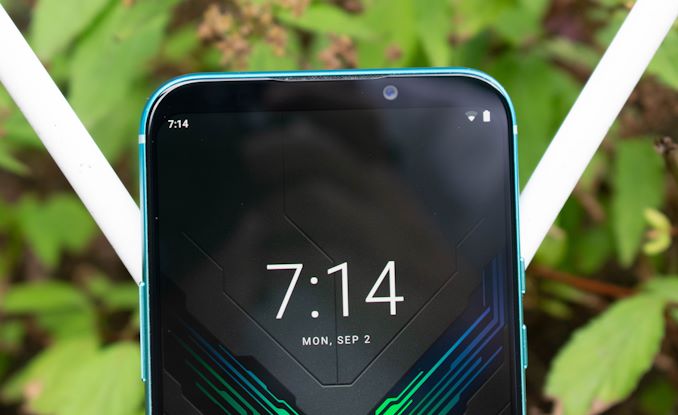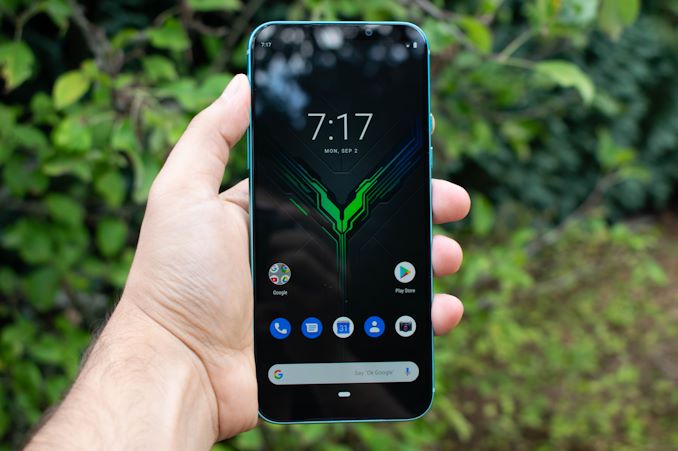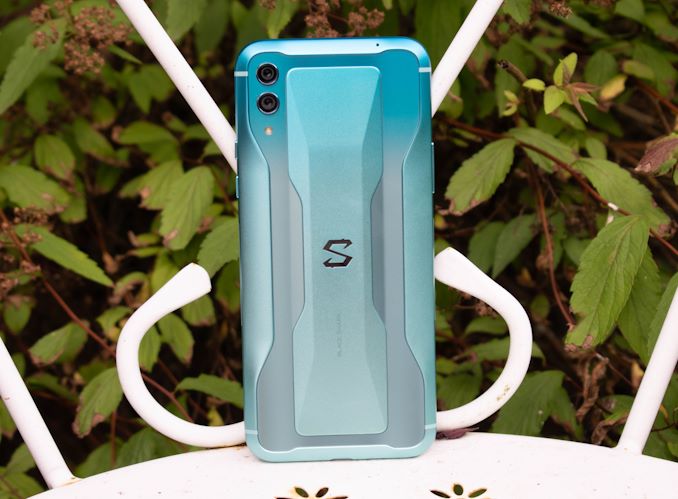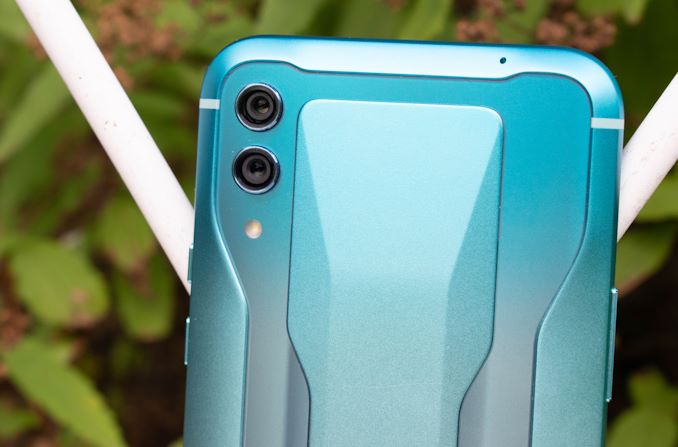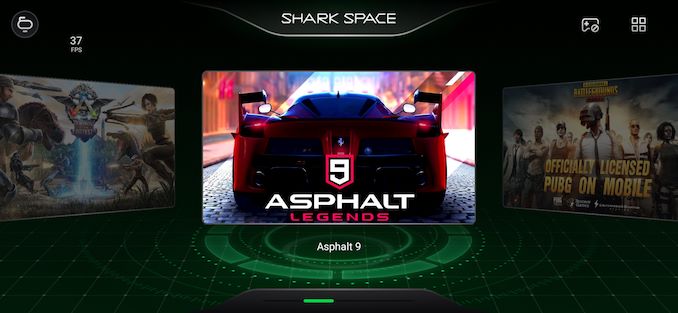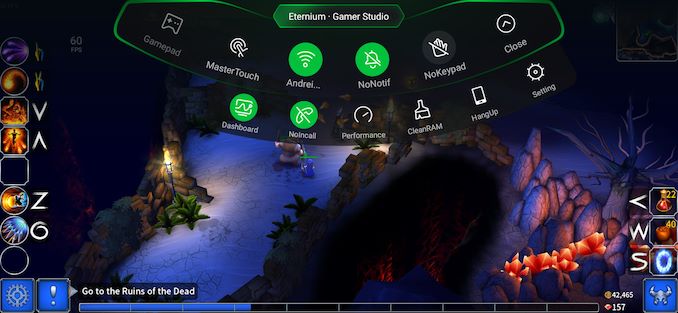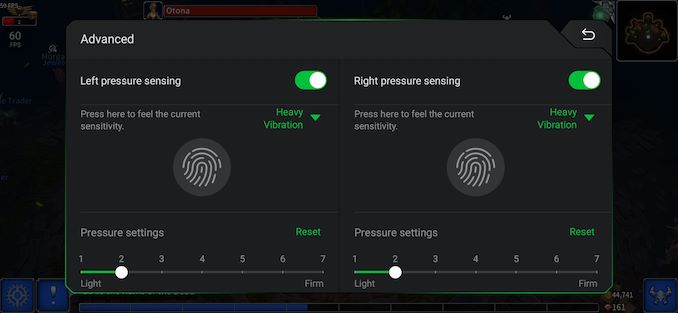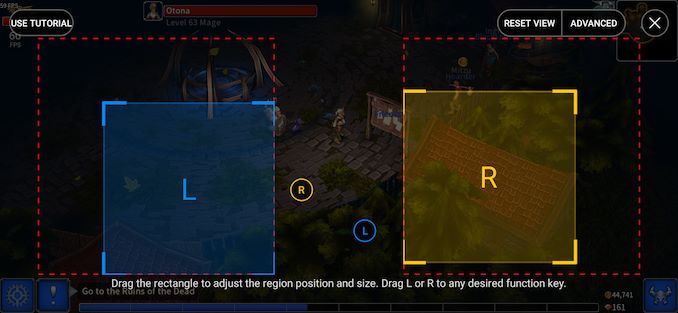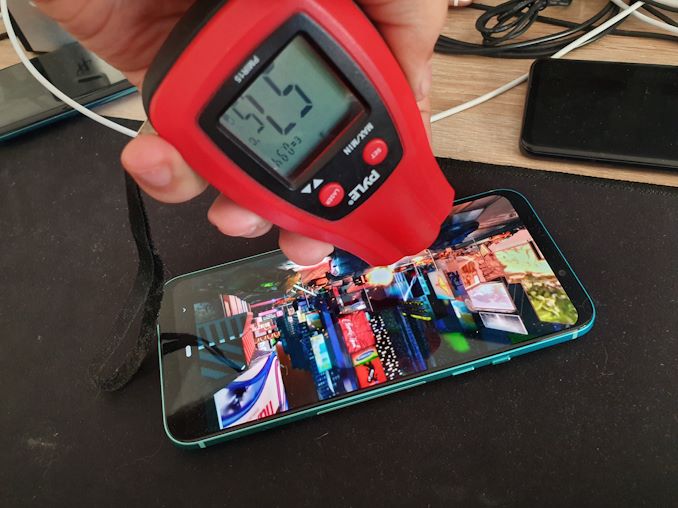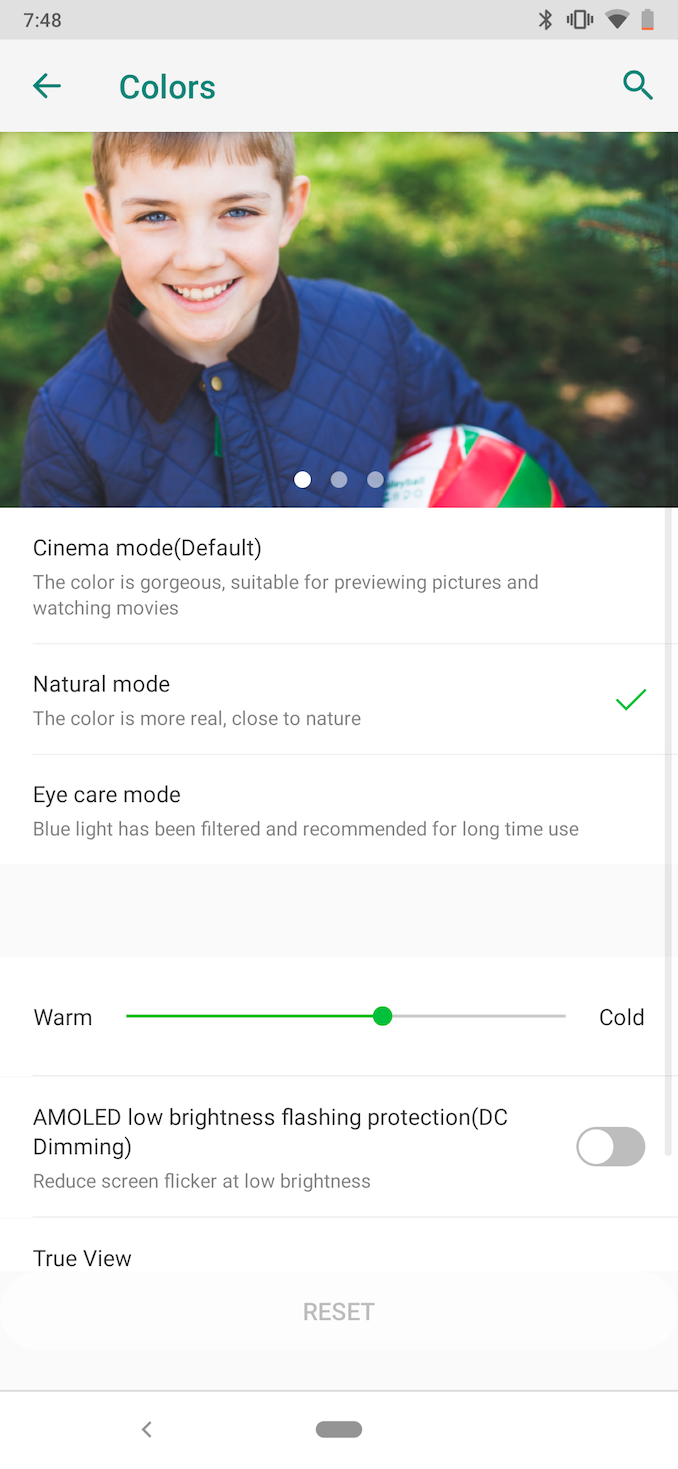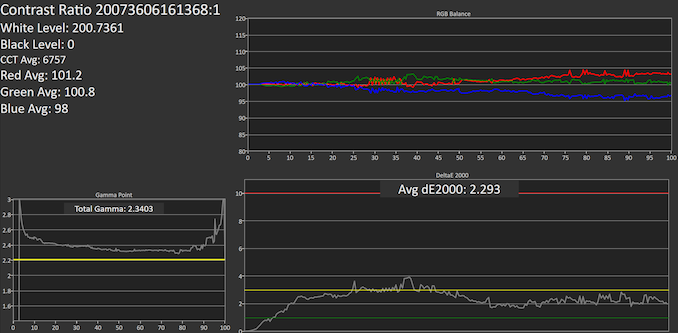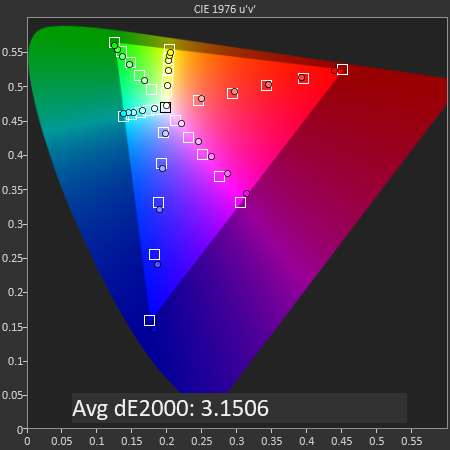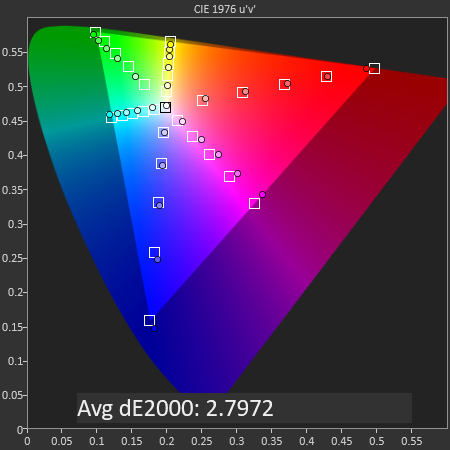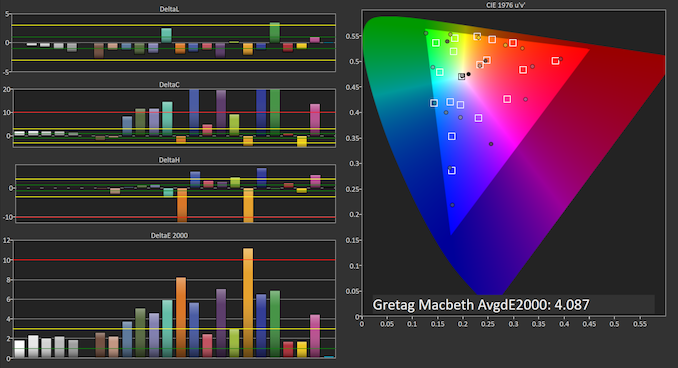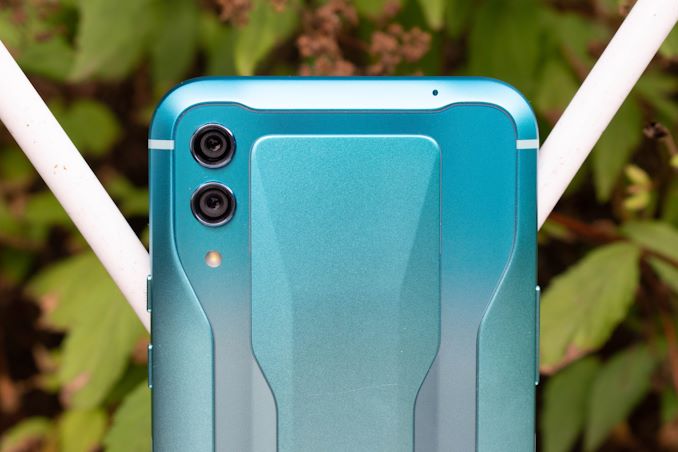
Original Link: https://www.anandtech.com/show/14716/the-black-shark-2-review
The Black Shark 2 Review: A Gaming Phone's Existential Crisis
by Andrei Frumusanu on September 25, 2019 8:00 AM EST- Posted in
- Smartphones
- Mobile
- Xiaomi
- Snapdragon 855
- Black Shark 2
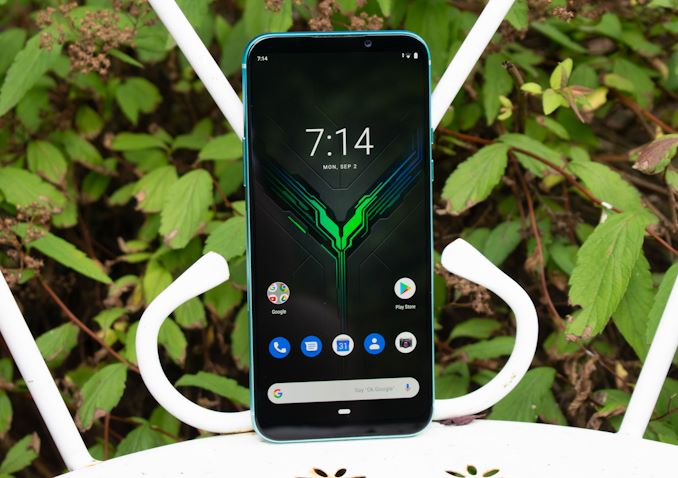
Over the last 1-2 years we’ve seen a new type of smartphone category start carving itself a niche in the market: the gaming smartphone. Last year, the original Black Shark was amongst the first devices to try to cater to a gaming audience, offering characteristic “gaming designs” as well as promising to offer software features to differentiate itself from the more usual smartphone offerings.
This year, Xiaomi has updated its Black Shark line and brand with the new Black Shark 2. The phone is very much a continuation of what we saw last year with the Black Shark, but offering the newest hardware innards and iterative improvements to the design and features.
The premise of a gaming phone is a bit of an odd one. The one aspect that differentiates classical gaming products from regular ones is their more exotic and futuristic design as well as the notion that they’re optimised for the gaming experience. I think the wider audience would understand the latter point as not only including features that simplify or augment the gaming experience, but also just plainly optimise the raw gaming performance of a device. In this regard, gaming phones pretty much just have one aspect in which they can greatly differentiate themselves and improve upon other “regular” devices: thermal design and heat dissipation. Indeed, more recently we’ve seen products that specifically try to highlight their improved thermal capabilities, which in turn allow for higher and longer sustained gaming performance. Today we'll be investigating how the Black Shark 2 fares in this area, and if it's able to fulfill the expectatons of a "gaming phone".
| Black Shark 2 | ||||
| Black Shark 2 | ||||
| SoC | Qualcomm Snapdragon 855 1x Kryo 485 (Cortex-A76) @ 2.84GHz 3x Kryo 485 (Cortex-A76) @ 2.42GHz 4x Kryo 485 (Cortex-A55) @ 1.80GHz Adreno 640 @ 585MHz |
|||
| DRAM | 8/12GB LPDDR4X | |||
| Display | 6.39" AMOLED 2340 x 1080 (19.5:9) |
|||
| Size | Height | 163.61 mm | ||
| Width | 75.01 mm | |||
| Depth | 8.77 mm | |||
| Weight | 205 grams | |||
| Battery Capacity | 3900mAh (Design) 4000mAh (Typical) |
|||
| Wireless Charging | - | |||
| Rear Cameras | ||||
| Main | 48MP IMX586 0.8µm pixel w/PDAF f/1.75 |
|||
| Telephoto | 12MP 1.0µm pixel f/2.2 2x optical magnification |
|||
| Wide | - | |||
| Extra | - | |||
| Front Camera | 20MP 0.9µm f/2.0 |
|||
| Storage | 128 / 256GB UFS 2.1 | |||
| I/O | USB-C no 3.5mm headphone jack |
|||
| Wireless (local) | 802.11ac Wave 2 Wi-Fi Bluetooth 5.0 LE + NFC |
|||
| IP Rating | none | |||
| Other Features | In-screen optical fingerprint sensor | |||
| Dual-SIM | 2x nanoSIM | |||
| Street Price: | 8+128GB: 549€ 12+256GB: 649€ |
|||
Naturally, a gaming phone requires the best SoC available, and in this regard the Black Shark 2 remains relatively in-line with what’s available in the market, featuring a Snapdragon 855 SoC. The SoC should enable excellent gaming performance as we saw the Adreno 640 to be quite competitive if it’s able to unleash full potential.
In terms of memory, the phone comes in either 8GB or 12GB RAM configurations, with either 128 or 256GB of UFS 2.1 storage.
The front of the phone is relatively classic and more in line with 2017 designs. We see a 19.5:9 aspect ratio AMOLED screen with at resolution of 2340 x 1080. In terms of gaming features, the one aspect in which the display differentiates itself isn’t by the panel itself, but rather by the touch screen. Here Xiaomi claims to offer a 240Hz touch controller which is meant to reduce input lag compared to other 60 or 120Hz devices in the market.
Indeed, in my subjective experience with the phone, I noticed that its touch responsiveness is much better than that of other devices. The tap latency improvements aren’t as quite noticeable in everyday usage, but the scroll latency is quite distinctively improved, with screen content able to follow one’s finger significantly better.
Overall while being a gaming phone, it’s not quite as oversized as you’d expect – at 75.01mm wide it’s still very much in the range of comfortable and useable by most people.
The back of the phone accentuates the whole design of the phone. The device is mainly solid aluminium – both on the sides as well as middle of the phone. The middle metal piece feels non-continous to the rest of the body of the phone, being interrupted by a glass inlay surrounding it. The design seems to help with the gaming aesthetics as well as the weight of the phone as there's a bit less metal employed. I’m not quite convinced by the build quality because when pressing the back near the “S” logo I can clearly feel the panel flex a bit and touch the internal components / battery, meaning there’s a small air gap on the inside.
Camera wise, the Black Shark 2 adopts a similar camera assembly as the Mi9, minus the wide-angle. The main sensor is again Sony’s IMX586 sensor, paired with an f/1.75 aperture lens. There’s no OIS on the phone which doesn’t bode too well, as we’ve seen the sibling Mi9 fall flat on its face in low-light conditions. The secondary module is a 2x magnification telephoto module with a 12MP sensor and an f/2.2 aperture.
The top and bottom of the phones are relatively barren – we see just a microphone hole at the top, whilst finding the USB-C connector as well as the dual nanoSIM slot at the bottom. The design is characterised by two large chamfers surrounding the phone, adding to the design of the phone.
The sides of the phone are a bit more populated; we find the regular volume rockers as well as power buttons on the left and right side, but we also find a toggle switch above the power button. This is the “Shark key” that puts the phone into Shark mode.
Alongside both sides we find two LED strips which can showcase the charge level of the device when charging – varying in strip length and colour from red to green.
On the software side of things, Shark mode and the "Shark Space" is essentially a secondary launcher interface that mimics the home screens of console UIs, with a basic listing of installed games as identified by the launcher. In the case that a game is not identified, you can still manually add apps to the list.
While in-game, you don’t really notice much difference to a regular phone, with the exception if you swipe from the bottom right (top right in landscape) corner you get an OSD menu with some options. In general, there’s not too much useful in here – under the advanced menu you get some performance monitoring options and notification toggles. There’s an FPS OSD overlay you can switch on, which can be interesting, although the CPU frequency and electrical current draw (not power) options are not very useful.
The one interesting and useful addition the Shark mode enables is “MasterTouch”, which is two pressure sensitive mapping areas which can be set up as actuation zones for configurable virtual click functions anywhere on the screen. This is actually an interesting addition and is particularly useful for shooter games where you’re using virtual analog sticks for movement and aiming, enabling you two additional functions without lifting your fingers off the screen.
Turning off gaming mode while inside a game doesn’t really change much and you still get your FPS OSD and MasterTouch still works - but flipping the toggle switch back on will interrupt your game and bring you back to the Shark launcher.
Overall, the software features of the Black Shark 2 were interesting but nothing really extraordinary that would dramatically differentiate the phone from other devices. The pressure sensitive screen and the MasterTouch feature I found was the only worthwhile addition to the “Gamer Studio” software suite.
Naturally, what should really define a gaming phone is its performance, so let’s move on to see how the software stack and hardware is optimised for this task.
System Performance
The Black Shark 2 was among one of the devices we’ve included in our Snapdragon 855 device roundup, so we should be plenty familiar with the device’s performance.
The summary explanation of diverging performance between different smartphones with the same SoC chipset is that vendors can deploy the software and firmwares at different stages of their development cycle. Some vendors try to keep things up to date with what Qualcomm provides, while others base off their firmwares some time early in the R&D cycle of the phone and then never update it again until a major Android update a year or more later.
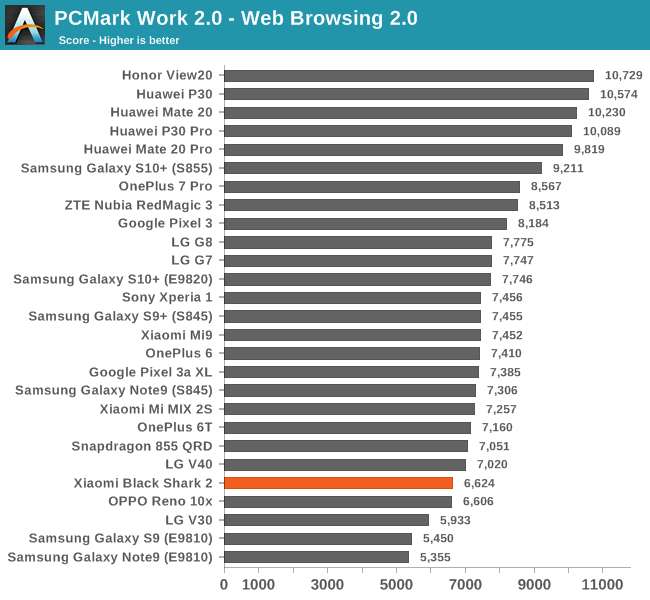
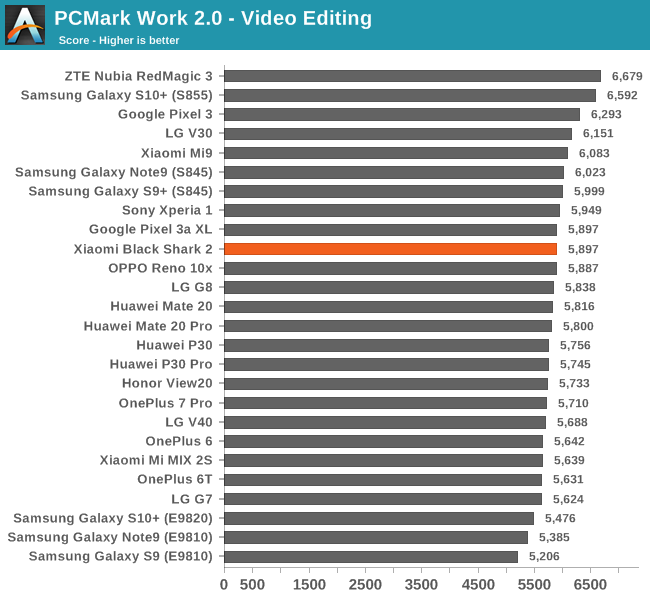
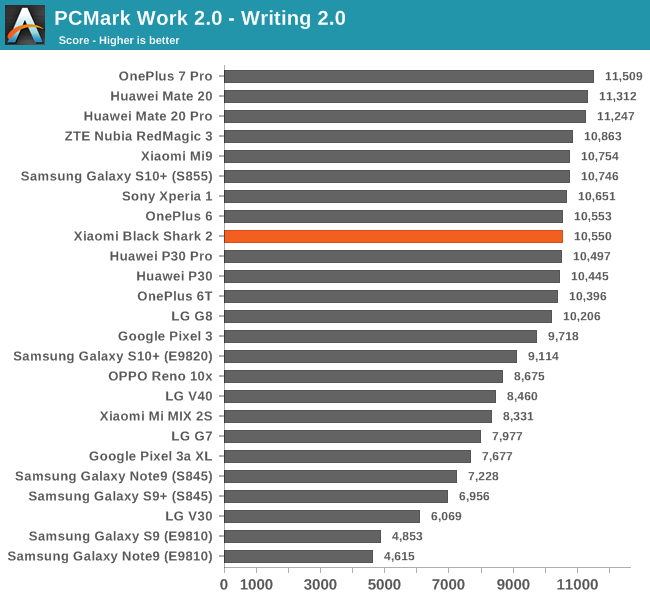
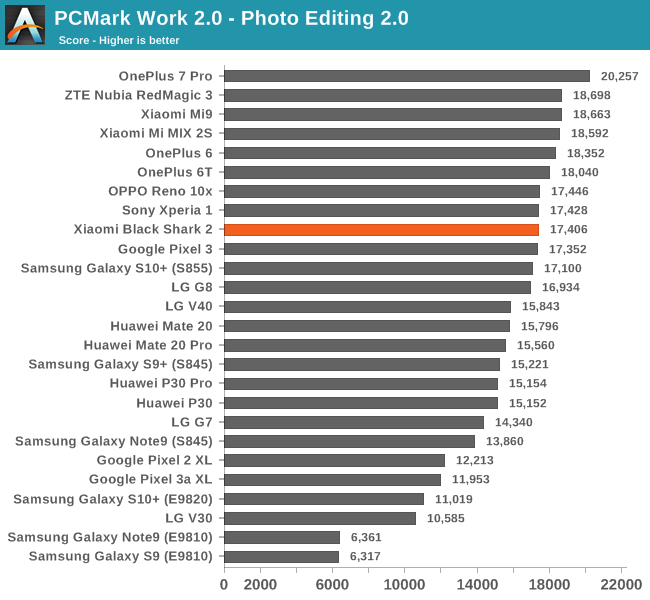
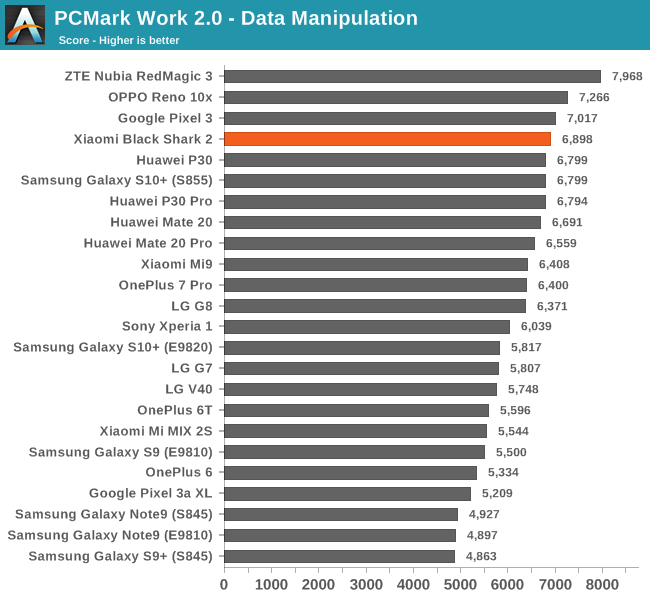
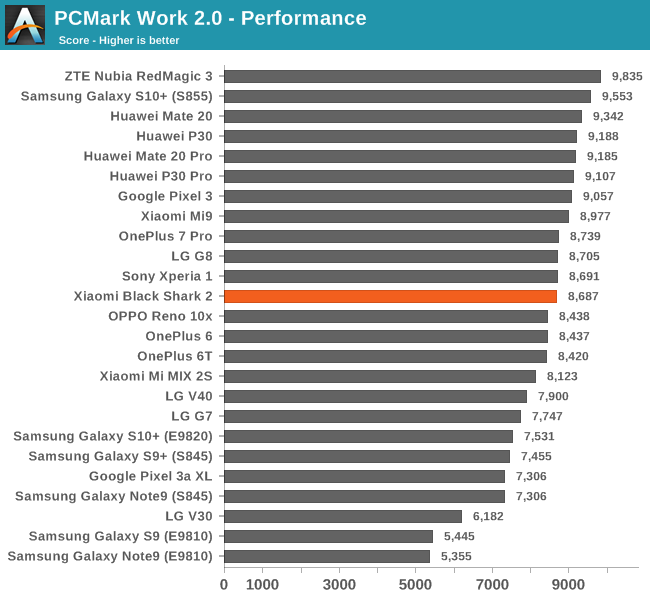
In PCMark, the Black Shark 2 preforms relatively average in relation to its other Snapdragon 855 siblings. The more interesting comparison here is against Xiaomi’s own Mi9; we’re seeing a few minor differences here and there but generally there isn’t too much divergence from its sister platform.
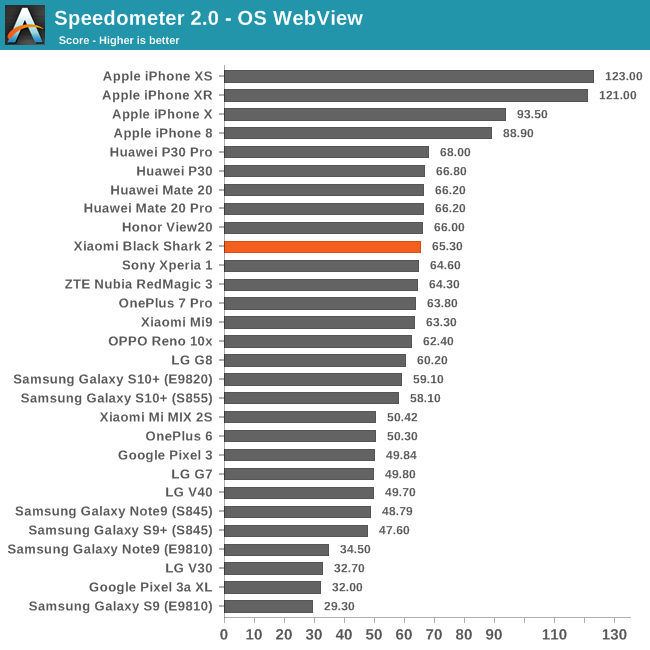
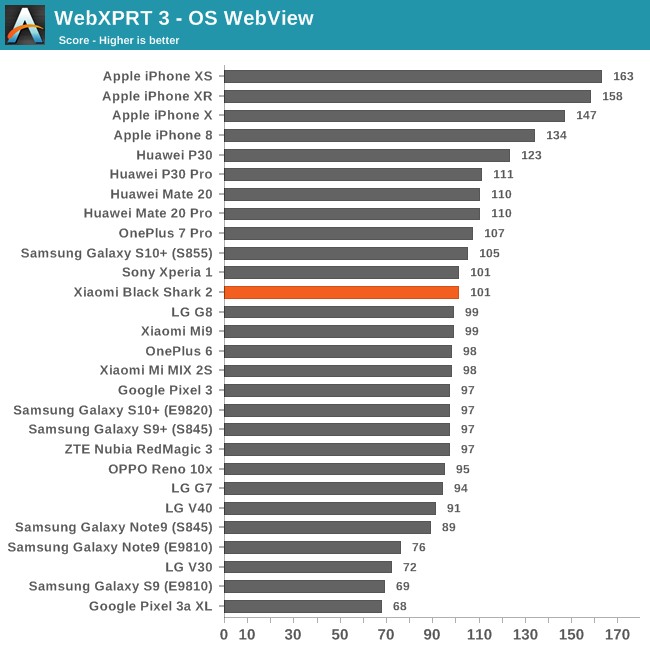
In the JS web browsing benchmarks, the Black Shark 2 actually performs well and in line with the better S855 platforms.
Overall, the performance of the Black Shark 2 is very good and in line with that of other Snapdragon 855 phones. It’s very similar to the Mi9 and that’s a good thing, albeit a bit short of the very best S855 tuned systems such as the Galaxy S10.
The more interesting aspect of performance is something we can’t really measure with benchmarks, and that’s the phone’s 240Hz touch input which does actually help quite a lot in terms of giving users a more fluid and less sluggish experience, something that’s especially visible in scrolling content.
Machine Learning Inference Performance
AIMark 3
AIMark makes use of various vendor SDKs to implement the benchmarks. This means that the end-results really aren’t a proper apples-to-apples comparison, however it represents an approach that actually will be used by some vendors in their in-house applications or even some rare third-party app.
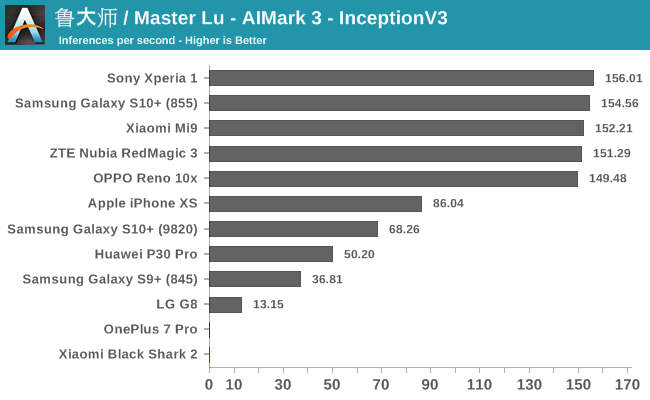
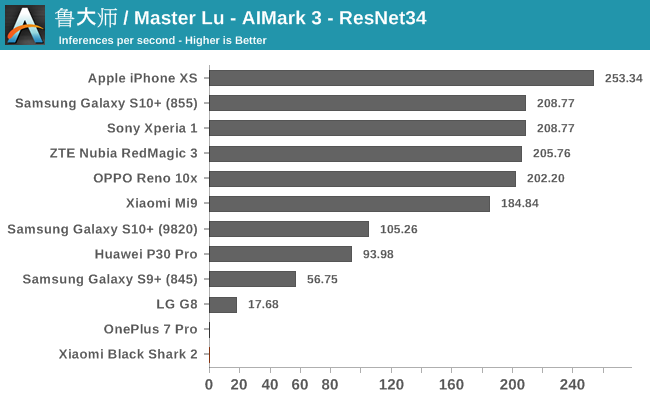
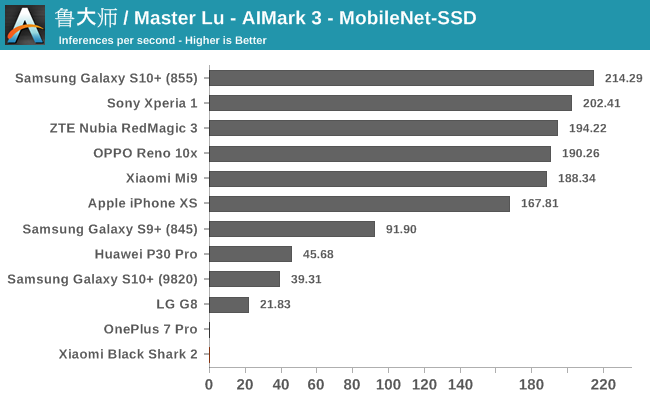
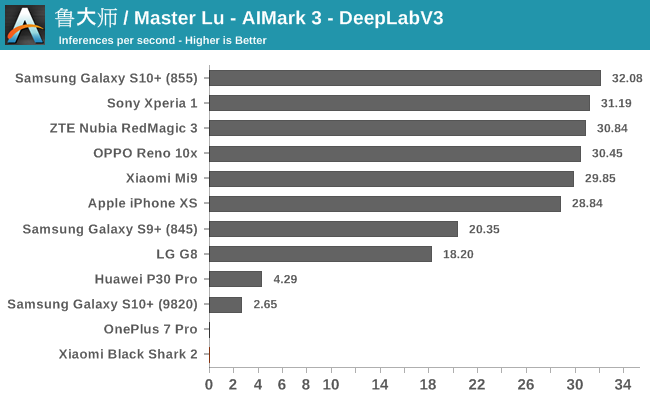
Unfortunately for the Black Shark 2, the devices lacked the proper drivers to properly run AIMark, and the benchmark repeatedly crashed upon starting the benchmarks. We had the same issue on the OnePlus 7 Pro, pointing out to some software incompatibility.
AIBenchmark 3
AIBenchmark takes a different approach to benchmarking. Here the test uses the hardware agnostic NNAPI in order to accelerate inferencing, meaning it doesn’t use any proprietary aspects of a given hardware except for the drivers that actually enable the abstraction between software and hardware. This approach is more apples-to-apples, but also means that we can’t do cross-platform comparisons, like testing iPhones.
We’re publishing one-shot inference times. The difference here to sustained performance inference times is that these figures have more timing overhead on the part of the software stack from initialising the test to actually executing the computation.
AIBenchmark 3 - NNAPI CPU
We’re segregating the AIBenchmark scores by execution block, starting off with the regular CPU workloads that simply use TensorFlow libraries and do not attempt to run on specialized hardware blocks.
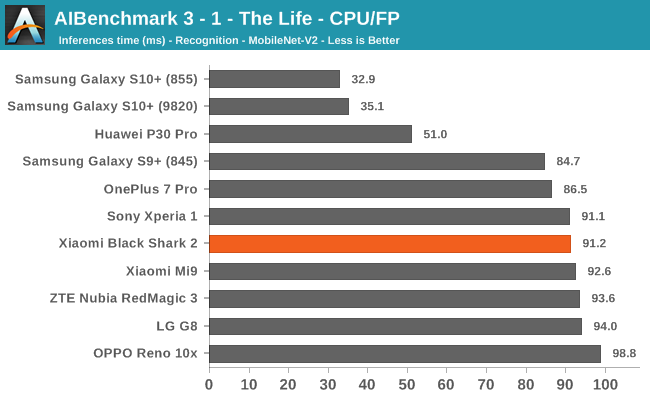
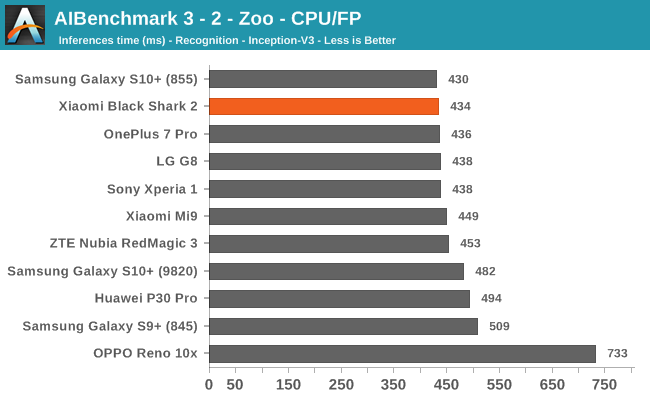
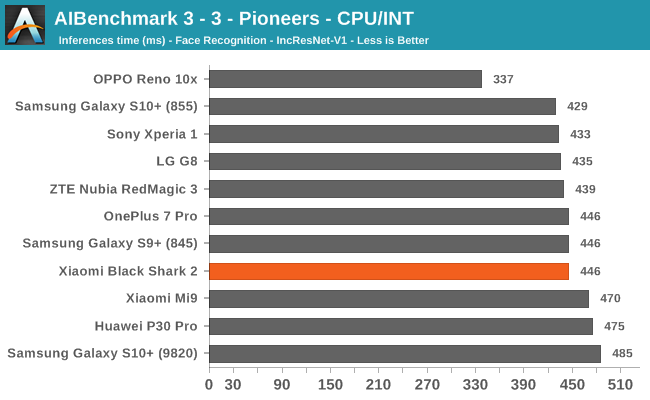
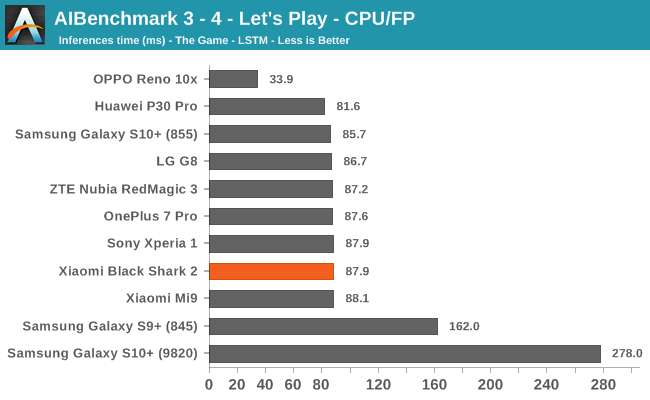
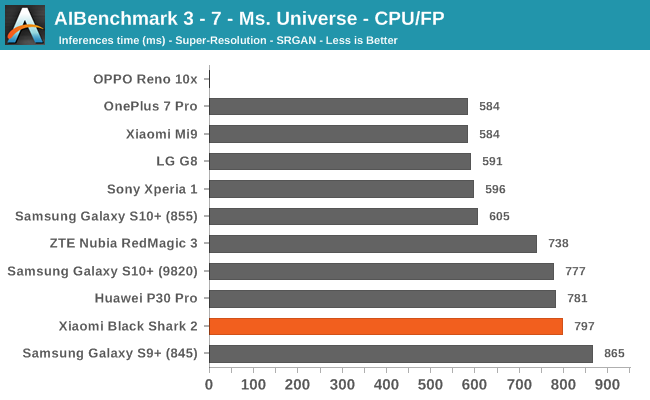
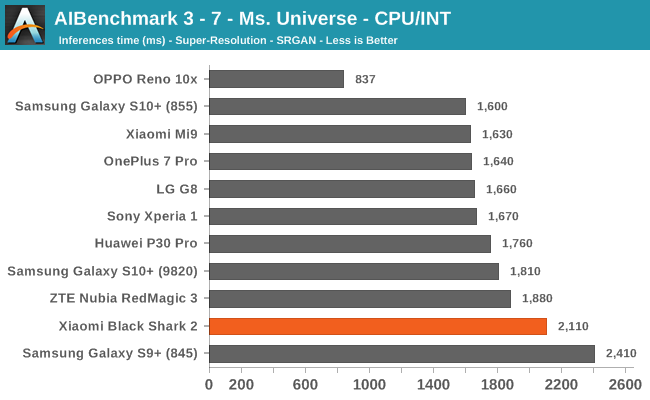
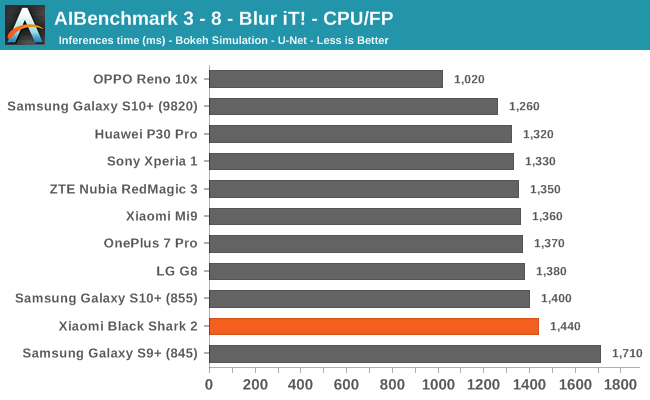
In AI Benchmark’s CPU workloads, the Black Shark 2 ends up with a bit of a odd spread of scores. In the shorter running benchmarks the phone is getting relatively average inference times, while on the longer running tests for some reason the BS2 falls behind other S855 devices. In fact it looks like the BS2 is landing as amongst the worse off S855 devices in the latter listed tests.
AIBenchmark 3 - NNAPI INT8
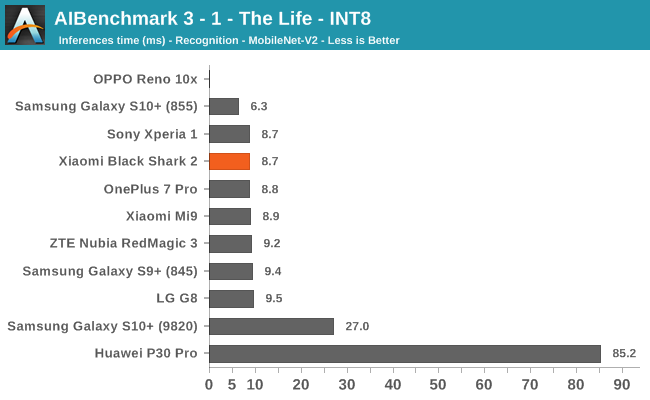
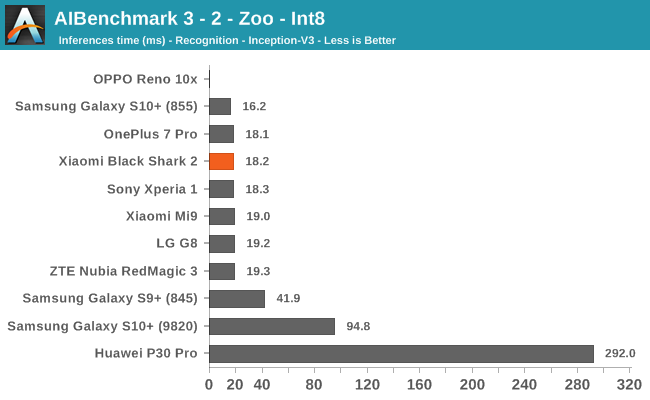
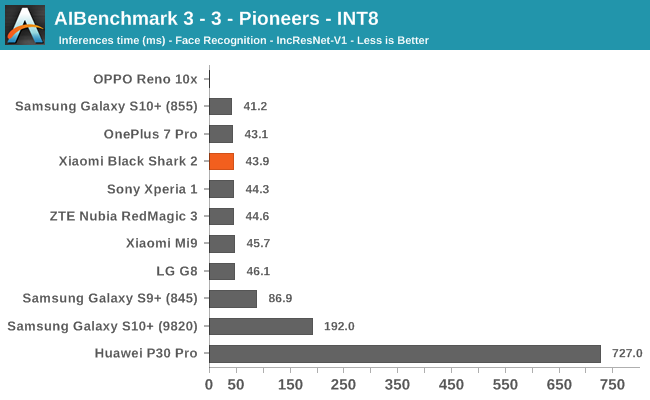
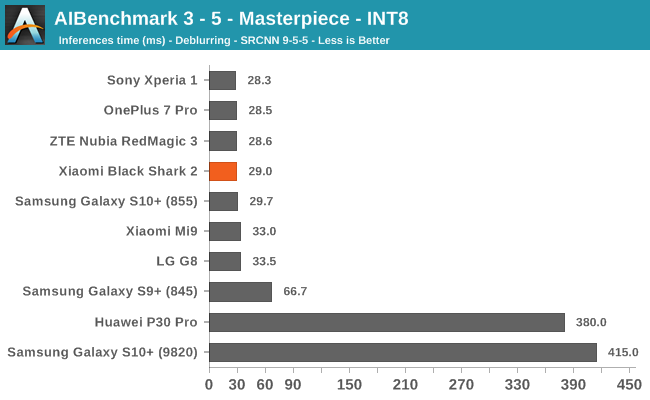
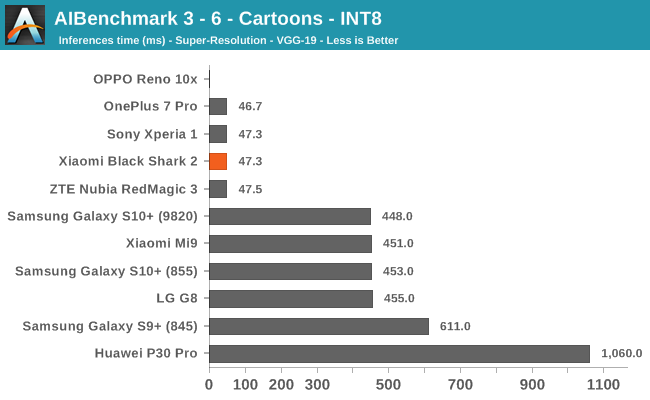
AIBenchmark 3 - NNAPI FP16
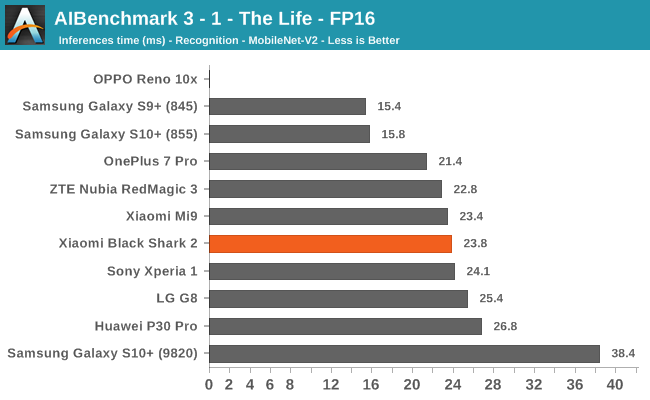
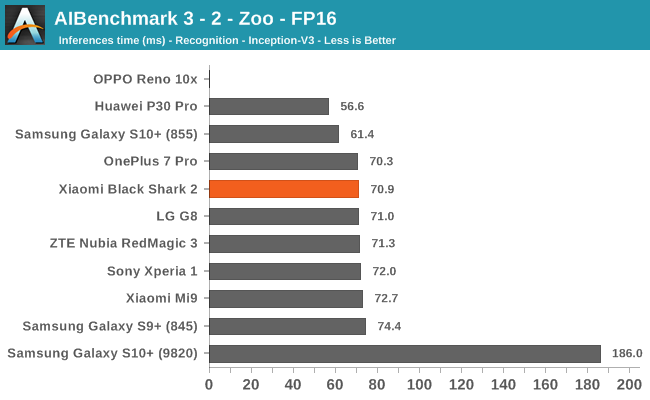
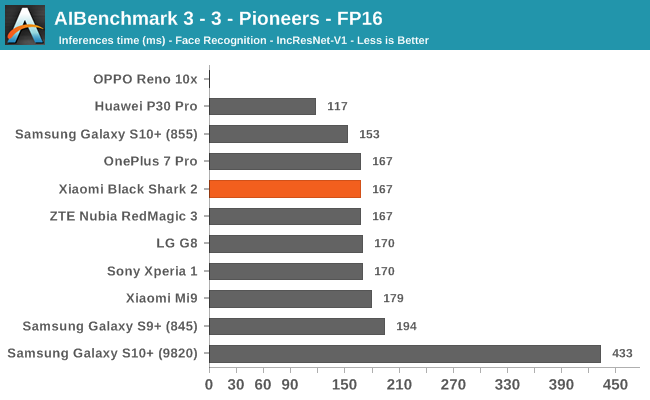
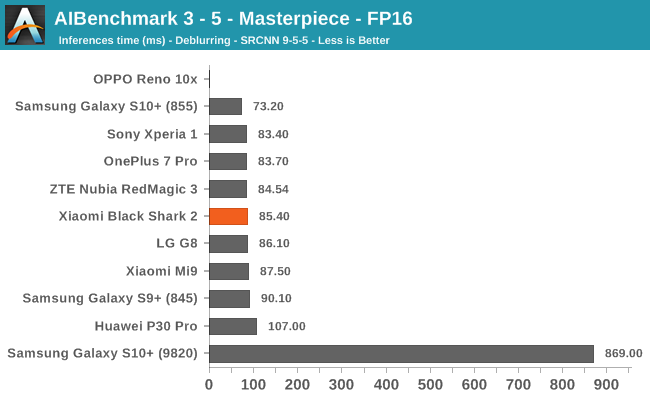
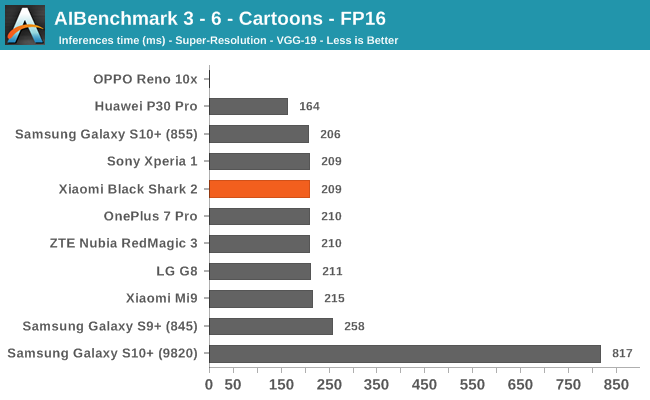
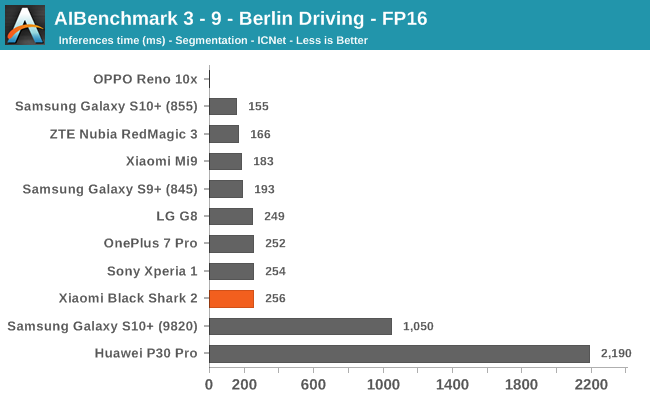
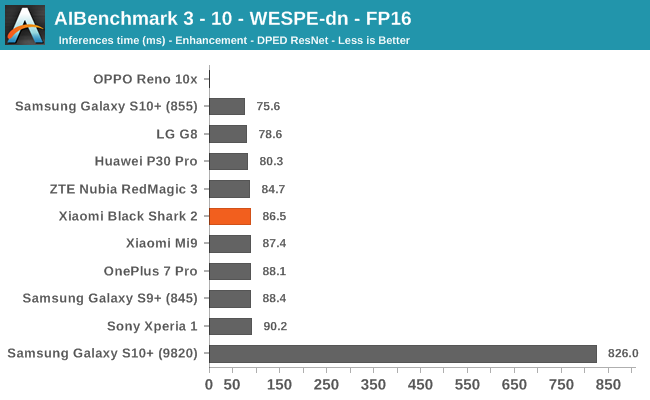
AIBenchmark 3 - NNAPI FP32
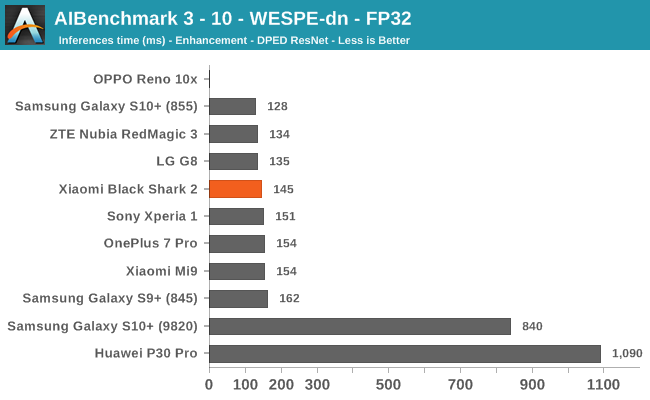
In the INT8, FP16 and FP32 accelerated tests which make use of acceleration blocks such as the Hexagon DSP and the GPU, we see the Black Shark 2 perform very well and in line with other Snapdragon 855 devices.
Overall, the Black Shark 2 is a good performer in the machine learning inferencing benchmarks, but like other devices, it’s not quite the very best in every regard, pointing out that the vendor could have improved upon its performance by keeping the software stack more up to date with what Qualcomm is offering, a widespread issue that I expect to persist over the next years as the ecosystem quickly evolves.
GPU Performance
GPU performance is arguably one of the most important aspects of a gaming phone, as you’re expected it to be optimised for such tasks. Gaming phones are usually a lot bulkier than regular designs, and this should enable the phone to have a larger thermal envelope helping dissipate heat off from the SoC.
My usual testing methodology is that I’m using customised versions of the benchmark applications – we work closely with the benchmark vendors and have access to non-public tools. Unfortunately one main reason of doing things this way is that in the past we’ve seen smartphone vendors detect the public variants of these benchmarks and enter in a special mode that would increase performance or disable thermal throttling mechanisms in order to artificially increase the reported benchmark numbers.
Unfortunately, the Black Shark 2 is one of these cheating devices. When using the public version of the given benchmarks, the phone detects this and disables thermal throttling. The problem with this is that seemingly the Black Shark 2 is very ill equipped with actually handling the high power dissipation of the SoC at peak performance. I saw device skin temperatures rise to a peak of 58°C before I decided to call it quits and stop the app – the phone had gotten so hot I couldn’t comfortably hold it anymore.
When using a customised version of the benchmarks, the phone would correctly thermal throttle and peak skin temperatures wouldn’t exceed ~43°C, which is more or less the standard maximum operating temperatures we’ve seen of smartphones over the years.
Unfortunately, this behaviour is not a first from Xiaomi. In the past I’ve encountered the same problem with the MIX 2S and actually also the first generation Black Shark. We never wrote up a review for the Black Shark, but the fact that this behaviour continues is just shameful of Xiaomi – especially given the non-cheating sustained performance scores of the Black Shark 2 which we’ll address now.
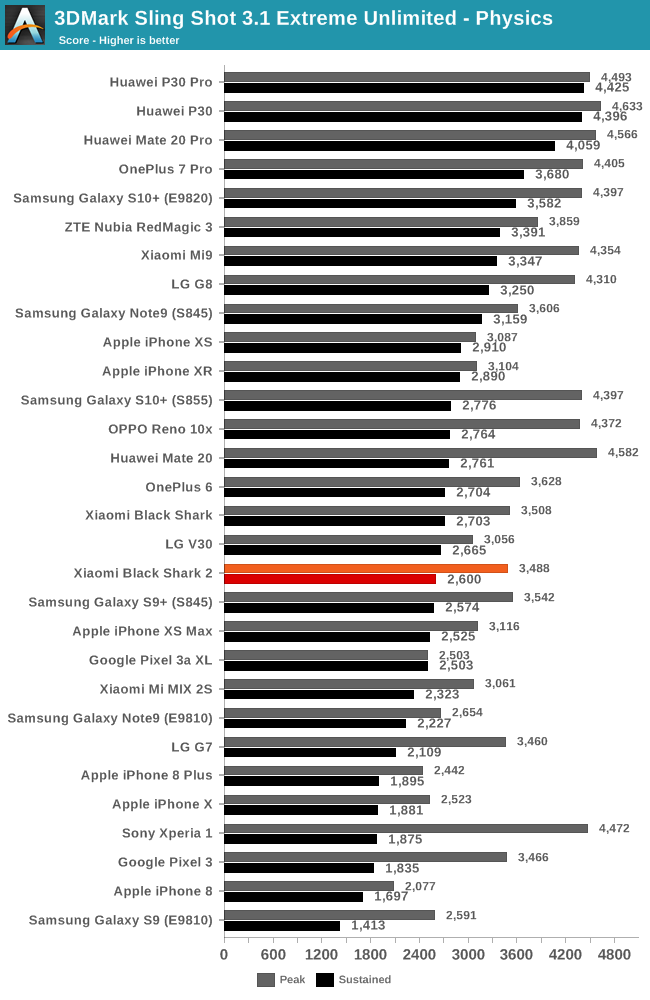
In the 3DMark Physics test which is more CPU bound, we see the Black Shark 2 perform quite oddly. It’s the only Snapdragon 855 device that has a significantly below-the-norm peak performance in this test, clearly much below that of other phones.
The sustained performance is more or less in line with other S855 phones, at least the ones which have more considerable thermal throttling behaviours.
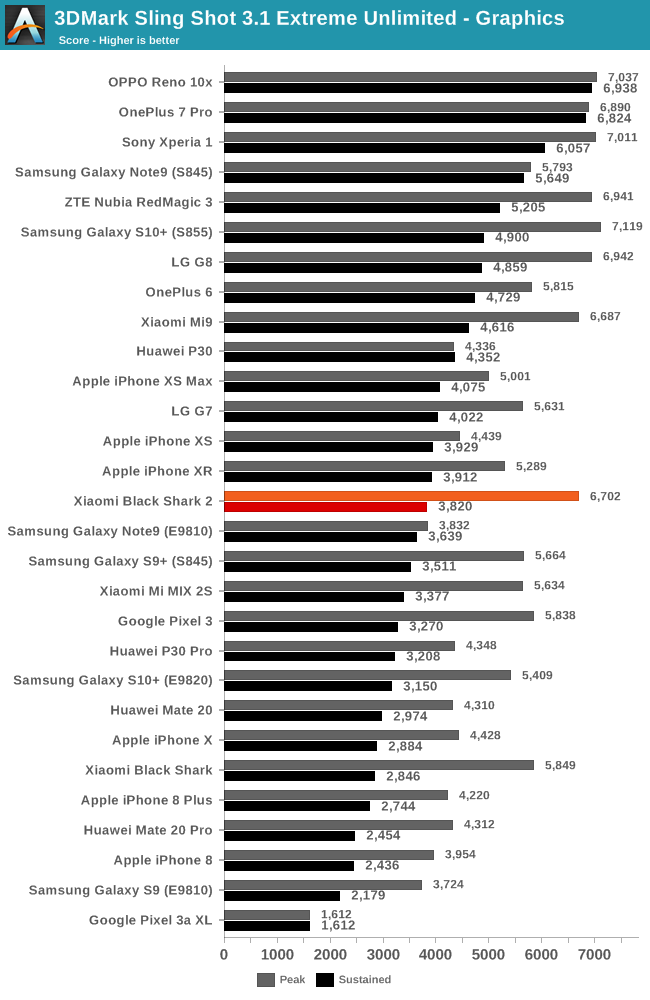
In the graphics benchmark, we see the Black Shark 2 suffer from a considerable performance drop, lowering to 57% of its peak performance, significantly lower than any other S855 phone.
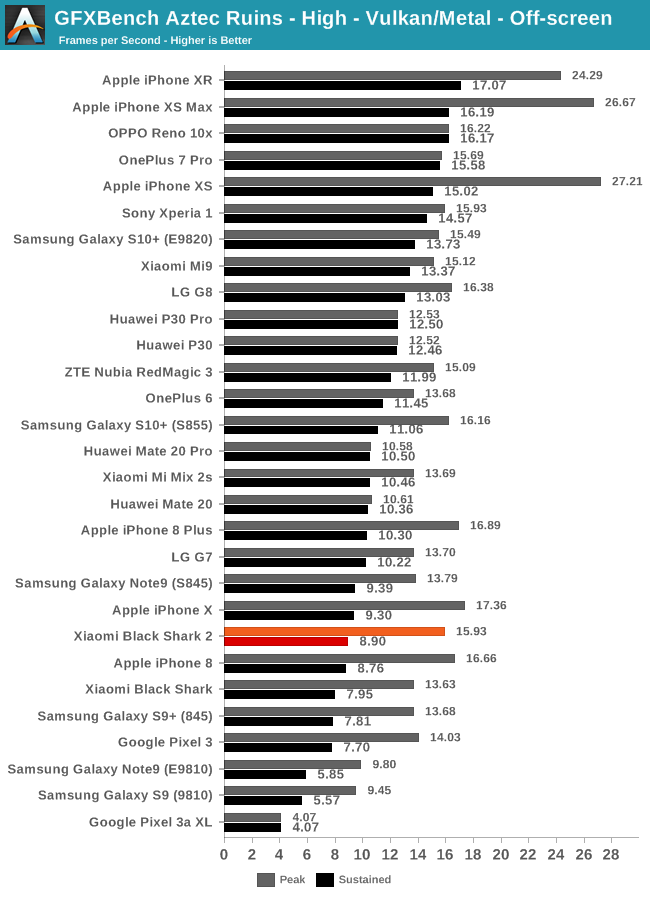
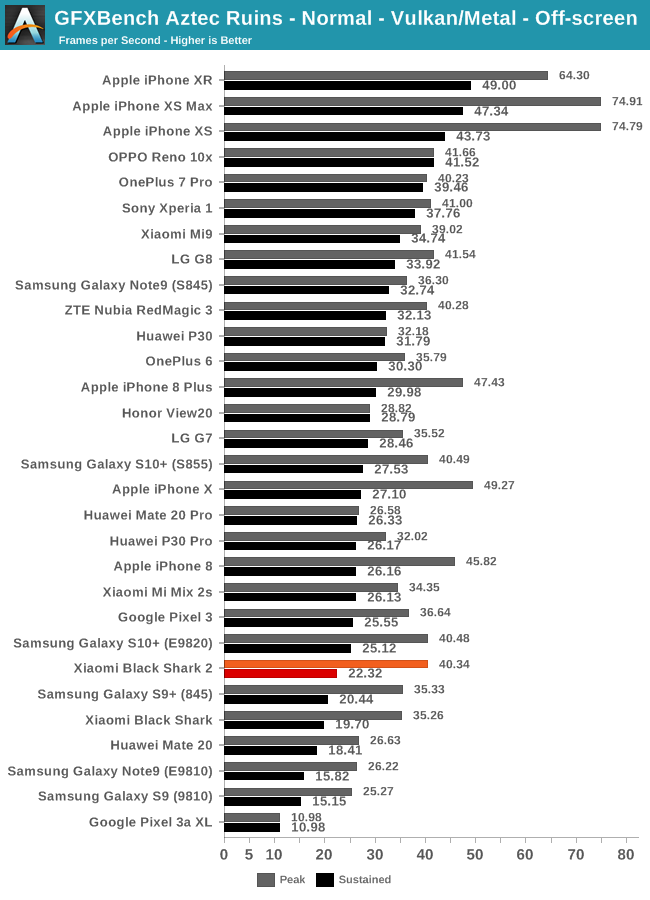
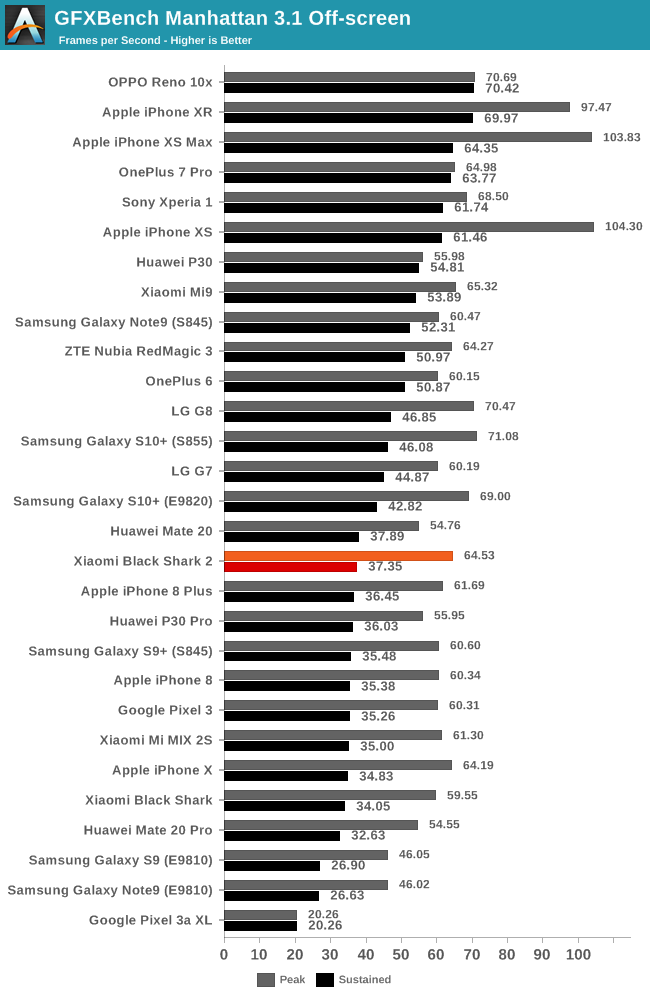
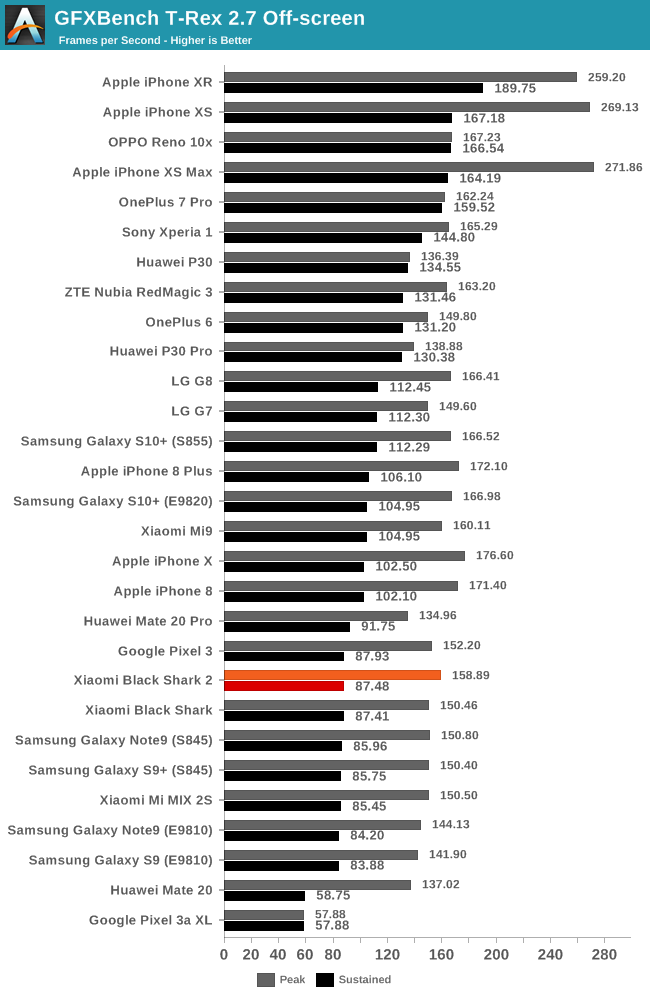
This meagre performance showcase continues on through all the GFXBench workloads, with the Black Shark 2 clearly ending up significantly slower than other Snapdragon 855 phones.
I included the original Black Shark scores into the data in order to showcase just how little the phone has improved over last year’s device.
I have a bit of a dilemma here; on one hand I should be praising the Black Shark 2 for maintaining reasonable device temperatures; this generations we’ve seen some phones such as the OnePlus 7 Pro and the OPPO Reno 10x not thermal throttle at all but also reaching peak skin temperatures in excess of 53°C. I haven’t found evidence of cheating on those phones, and I do hope they’re legitimate and they don’t simply have a more sophisticated detection mechanism.
On the other hand, this is a gaming orianted phone, and its sustained gaming performance is simply the worst of any flagship phone in 2019. We’ve seen significantly better results from other devices, and even Xiaomi’s own Mi9 performs better than the Black Shark 2. The only explanation I have here is that the phone’s hardware and thermal design just isn’t any good. The original Black Shark was also quite a massive disappointment in its sustained performance scores, and the BS2 simply didn’t improve the situation much at all.
If you’re considering the Black Shark 2 because of expectations of better gaming performance, then this phone is not for you, and you can as well just stop reading the review right here.
Display Measurement
The Black Shark 2 comes with a 6.39” 2340 x 1080 AMOLED screen from Samsung. Aside from the 240Hz touch panel input rate, there’s nothing too special about the display and it’s the standard minimum we expect of a smartphone nowadays. As always because of the OLED technology, we’re seeing very good contrast ratios and great viewing angles.
Software wise, the phone offers a lot of options. The basic viewing modes include the “Cinema Mode” which is a Display P3 gamut target colourspace, and the “Natural Mode” which is targeting sRGB. Both phones have an independent colour temperature slider option.
On top of that, the phone also offers a DC dimming mode as opposed to PWM operation – the OLED panel lowers its brightness no longer by pulsing its LEDs but rather than varying the amplitude of the LEDs. The mode helps with eye strain for people which are sensitive to the PWM refresh frequencies, but comes at a cost of colour accuracy and screen uniformity as lowering the amplitude of the LEDs comes at a cost of the DDIC’s ADC’s effective bit-depth which is driving the LED voltages.
We move on to the display calibration and fundamental display measurements of the Black Shark 2 screen. As always, we thank X-Rite and SpecraCal, as our measurements are performed with an X-Rite i1Pro 2 spectrophotometer, with the exception of black levels which are measured with an i1Display Pro colorimeter. Data is collected and examined using SpectraCal's CalMAN software.
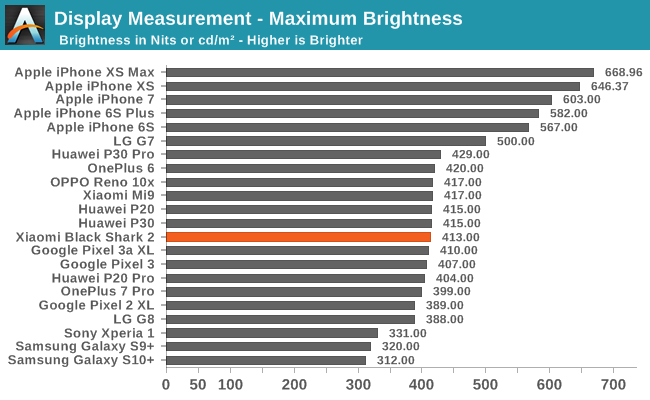
In terms of brightness, the display is in line with previous generation AMOLED screens, reaching a peak manual brightness of 413 nits. Enabling Adaptive Brightness on the Black Shark 2 doesn’t seem to enable the panel to go any further that that.
We’re measuring the greyscale accuracy in the “Natural sRGB” mode, and in terms of default colour temperature that the phone chooses, it’s relatively good (compared to some other vendor’s choices) with an average CCT of 6757. It does showcase a very slight variations towards red but nothing that would be immediately noticeable.
The larger issue seems again to be the fact that the panel’s gamma is a tad too high at 2.34. We’re measuring the greyscale patterns an APL of 50 and window size of 50%. When measuring at APL100W100, the phone actually measures in with a gamma of 2.2 which is accurate. It means that the phone’s screen calibration methodology is inaccurate as it doesn’t account for the APL brightness scaling of the panel.
The end effect is that some tones, especially below mid-levels, will appear slightly darker than they should be.
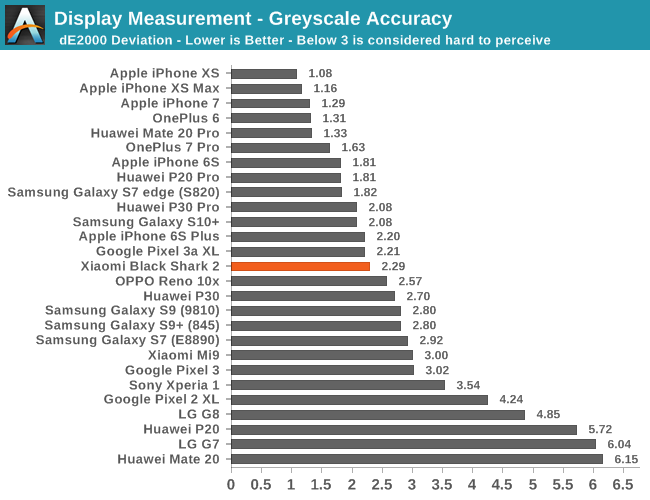
Overall, because of the relatively ok colour temperatures as well as the not too big gamma deviation, the greyscale deltaE2000 error rate is 2.29, which is still good and a lot better than some other devices out there, although not competitive against better devices in the market.
First off we’re testing the saturation points in the sRGB Natural mode. In terms of gamut, things look OK but we do see slight hue shifts in the red and blue channels. The peak blue intensity is also exceeding the gamut target, while the reds aren’t fully reaching it. Magentas are also off-hue.
The bigger problem is in the green channel. Here we’re seeing large levels of saturation compression, with the low and mid-levels being far too high in saturation.
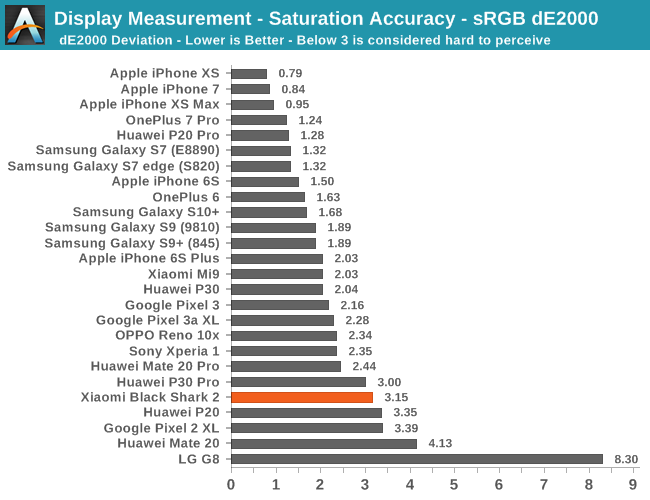
Because of the compounded errors, the Black Shark 2’s Natural mode ends up with a dE2000 of 3.15, which is quite below average and notably worse than recent flagship devices.
The Cinema mode targets the P3 gamut, and we see that it largely adheres to the standard in this regard. Still, we’re seeing the same deviations as on the sRGB mode, as the reds peak is a bit off-gamut, the blue is exceeding it, magenta hues are off, and the green low and mid saturations are again too strong.
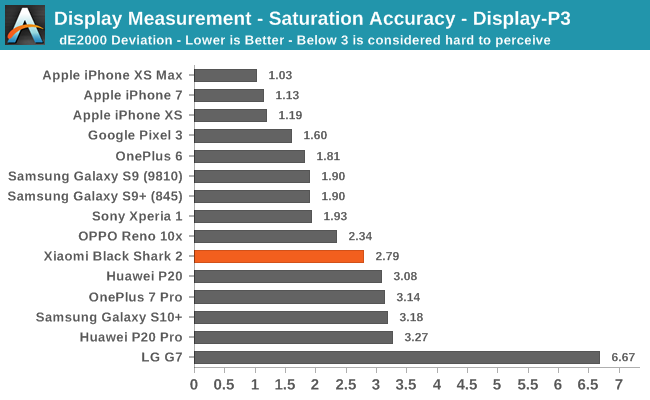
In this mode, the error is slightly better than that of the sRGB mode, ending up with a dE2000 of 2.79.
In the Gretag Macbeth colour palette of common tones and skin tones, we’re seeing some extremely big deviations. There are some big issues with the chromacity of some tones, with far too high saturations. There are also a few patches which are quite off-hue.
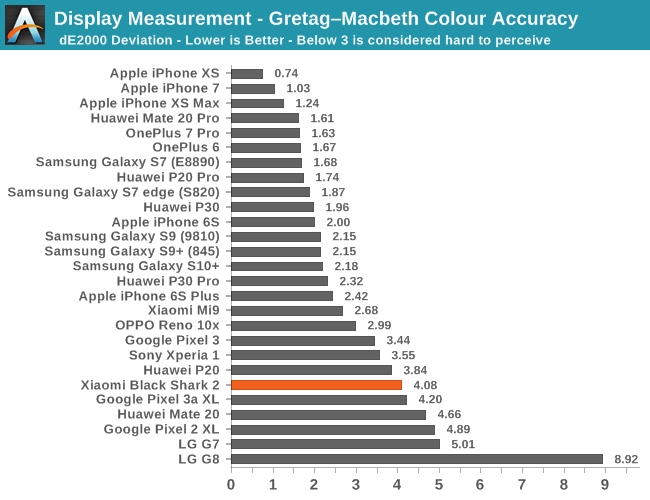
In the Gretag Macbeth colour palette of common tones and skin tones, we’re seeing some extremely big deviations. There are some big issues with the chromacity of some tones, with far too high saturations. There are also a few patches which are quite off-hue.
The phone ends up with a bad resulting GMB dE2000 of 4.08, again amongst one of the worst out there. The problem here is that’s unlike other phones whose errors lie mostly in inaccurate gamma and luminosity levels, the BS2’s calibration errors lie mostly in the saturation and hues of colours, which can be a lot more noticeable.
Overall, while the core display characteristics of the Black Shark 2 display are acceptable, its calibration is unsatisfactory and below-par.
Battery Life
The Black Shark 2 comes with a 3900/4000mAh battery, and given we’re not seeing any other particularly power hungry components in the phone, we should be expecting the phone to perform relatively well in terms of its battery life.
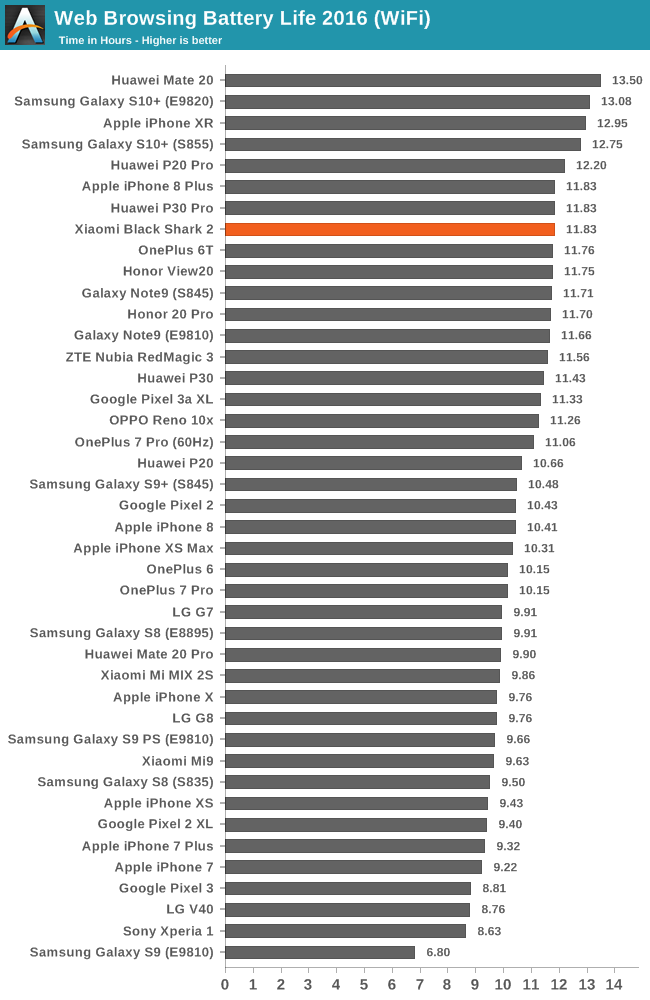
In the Web Browsing test, indeed we see the BS2 last quite long at 11.83h – among the better devices out there in the market and the second-best Snapdragon 855 device behind the Galaxy S10+. Samsung here still has an advantage due to a more efficient screen, even though it’s also higher resolution.
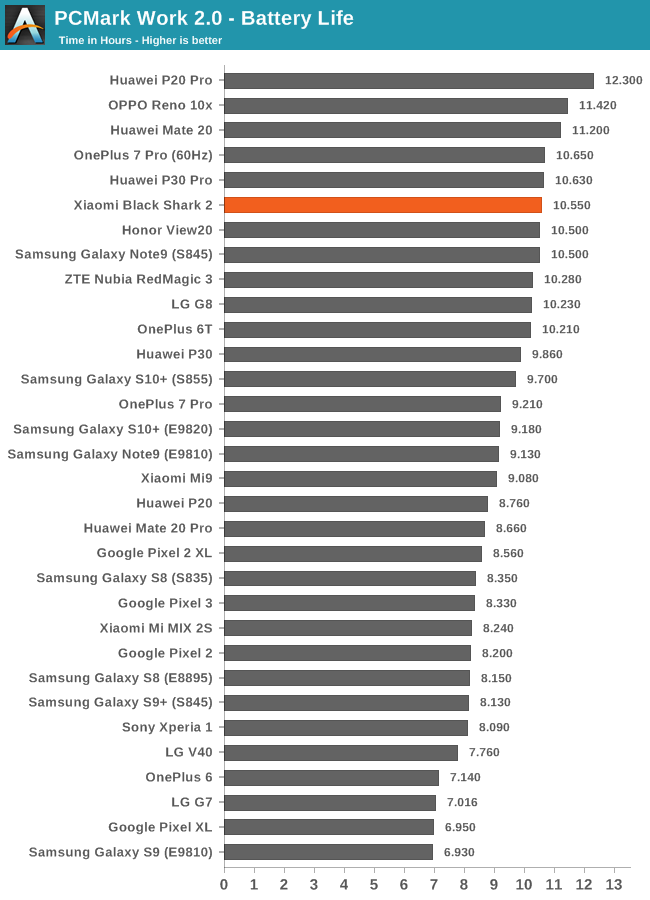
In PCMark, the BS2 also does quite well. The better efficiency here can be explained by the fact that the phone is slightly more conservatively tuned in terms of its performance, using the more efficient performance states more than more aggressively tuned phones.
Overall, battery life of the Black Shark 2 is very good and lands exactly where you’d expect it to.
Camera - Daylight Evaluation
The camera performance of the Black Shark 2 is something that in theory should be extremely similar to the Xiaomi Mi9 – both phones are after all from the same vendor and employ the same camera sensor and similar optics. The one area where the BS2 differs in is that its secondary camera is just a regular 2x telephoto lens in a year where most vendors have opted to prioritise wide-angle modules.
I have to apologise for the vendor label on the photos of the BS2 – I hadn’t realised it was enabled until after I had captured the camera shots.
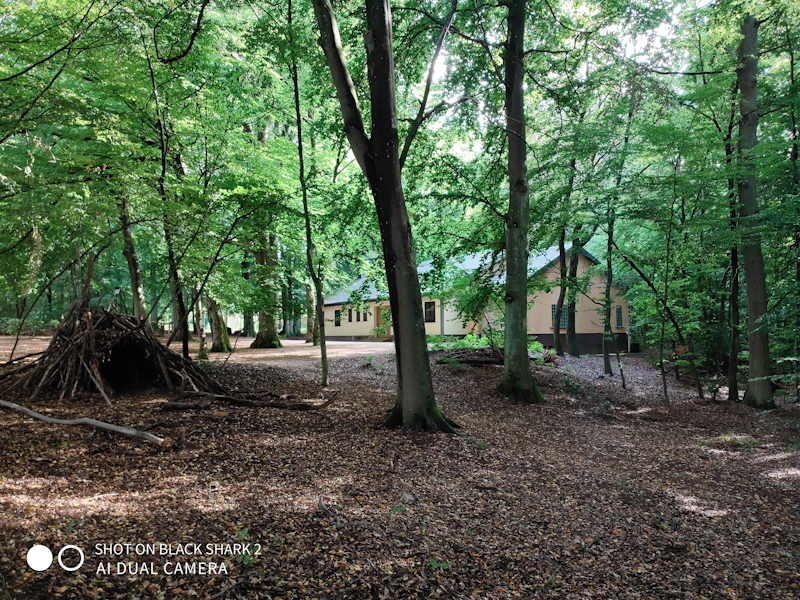
[ BlackShark 2 ] - [ S10+ (E) ] - [ S10+ (S) ]
[ Xperia 1 ] - [ P30 Pro ] - [ Mi9 ] - [ G8 ]
[ Reno 10x ] - [ RedMagic 3 ] - [ Pixel 3 ] - [ iPhone XS ]
In the first shot, the results actually start out quite disappointing as there’s a massive difference to the result of the Mi9. The BS2’s shot has completely wrong colour temperature and the whole scene is far too grey – a common issue with this scene that I’ve encountered with a lost of phones in past reviews.
While exposure and highlight retention seems similar, the BS2 seems to darken the shadows more than the Mi9.
The zoom lens photo in this shot is weird as it doesn’t look like it used the telephoto sensor at all, and it just looks like a crop of the main sensor with all of its disadvantages.
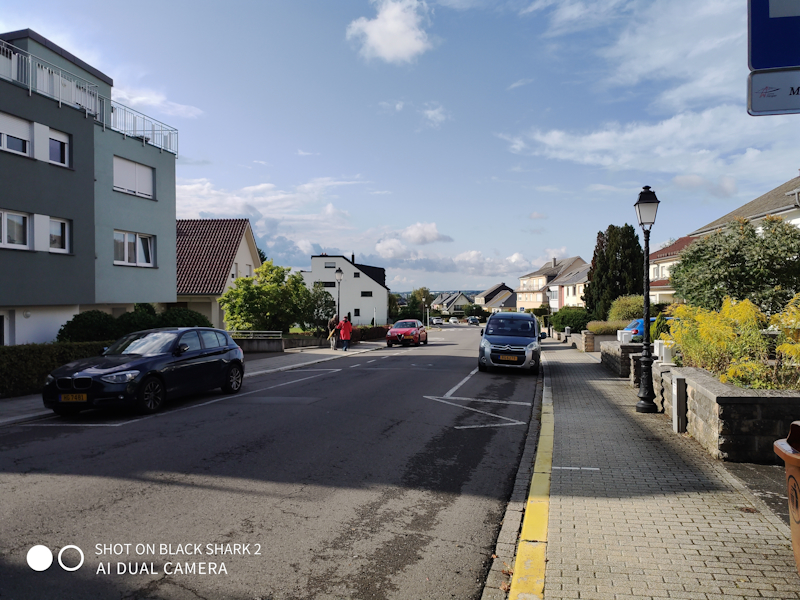
[ BlackShark 2 ] - [ S10+ (E) ] - [ S10+ (S) ]
[ Xperia 1 ] - [ P30 Pro ] - [ Mi9 ] - [ G8 ]
[ Reno 10x ] [ RedMagic 3 ] - [ Pixel 3 ] - [ iPhone XS ]
This next shot again shows very dark shadows. Looking at the EXIF, the BS2’s exposure was one fourth as long as the Mi9’s, resulting that the top 15% of levels in the image are just nonexistant.
On the zoom shot, the BS2 this time around did use its dedicated sensor. Colour temperature this time around was better than the Mi9, and exposure is also ok. When looking at details though we’re seeing very different results as the BS2 is visibly employing a contrast and sharpening filter while the Mi9 remains natural.

[ BlackShark 2 ] - [ S10+ (E) ] - [ S10+ (S) ]
[ Xperia 1 ] - [ P30 Pro ] - [ Mi9 ] - [G8 ]
[ Reno 10x ] - [ BlackShark 2 ] - [ RedMagic 3 ]
[ Pixel 3 ]
On the main camera here in the flowers the BS2 does actually a lot better than the Mi9 due to more accurate colour temperature and a lot more preserved detail. Even though both cameras showcase the same image brightness in terms of levels, the BS2’s exposure here is at 1/500th second while the Mi9 was at 1/192th second. The lack of OIS on both phones would favour the faster exposure due to less shaking, and I think that’s possibly why the BS2 looks to have retained a lot more detail.
On the zoom module we again see that the BS2 employs a heavy contrast and sharpening filter, which does bring out the edges in objects, however it also blurs out finer low-contrast detail.
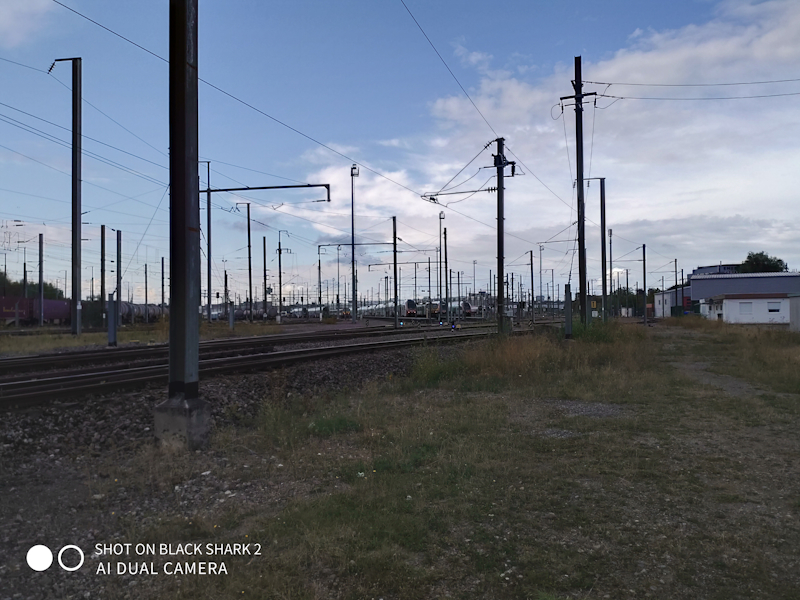
[ BlackShark 2 ] - [ S10+ (E) ] - [ S10+ (S) ]
[ Xperia 1 ] - [ P30 Pro ] - [ Mi9 ] - [G8 ]
[ Reno 10x ] - [ RedMagic 3 ] - [ Pixel 3 ] [ iPhone XS ]
The BS2 didn’t fare well here in this shot as it’s far too underexposed in favour of the sky. Details in the scene is also quite decimated as it’s blurry and it looks washed out, there’s a huge difference to the Mi9 here.
The zoom shot is also a bit underexposed, but the bigger issue is again the sharpness filter that manages to blur together all the detail in the foreground grass.
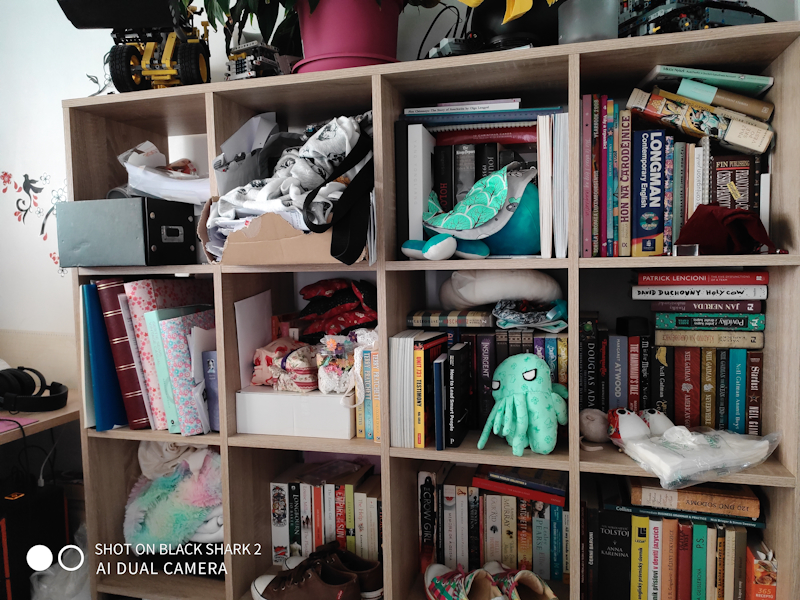
[ BlackShark 2 ] - [ S10+ (E) ] - [ S10+ (S) ] - [ Xperia 1 ] - [ P30 Pro ]
[ Mi9 ] - [ G8 ] - [ Reno 10x ] - [ RedMagic 3 ] - [ Pixel 3 ] - [ iPhone XS ]
In this last indoor shot the BS2 gets a lot more detail than the Mi9 due to the much lower ISO used. The problem is that the shot looks quite unnatural and with far too much contrast with the shadows being extremely pronounced.
Daylight Camera Conclusion
On paper, the Black Shark 2 should have been a good performer in daylight and essentially it just had to match what the Mi9 had to offer in terms of processing. Unfortunately, that’s not the case and the two phones have relatively little in common other than they share very similar camera hardware. The BS2 wasn’t able to showcase the same positive characteristics as its sibling device, and is simply just worse in almost every scenario. The telephoto lens was also very different in terms of results, and showcased a very detrimental contrast and sharpening filter that blurred out finer details of the scene in favour of lower-resolution high contrast detail. It’s good for thumbnails or medium resolution shots, but not good if you want the actual full resolution of the camera.
Camera - Low Light Evaluation
We’ve had the Reno 10x in camera comparisons in previous articles, but as mentioned in the introduction of the device, Oppo was able to update its software over the last few months. The one area where there has been significant advancements in is in terms of low-light photograph and an apparent new night mode.
Previously, the original Night mode on the Reno was a dedicated mode one had to select to use. In newer firmware updates, the Reno now will automatically select a new kind of night mode in lower light conditions, and this is characterised by the camera app doing three quick shutter animations and sounds. We’ll see how this has changed, and how the new mode compares against the competition.
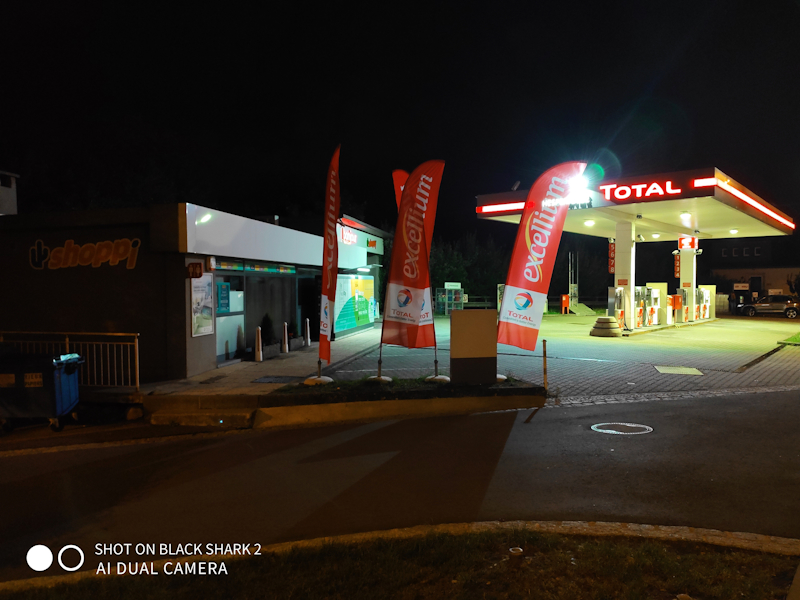
[ BlackShark 2 ] - [ S10+ (E) ] - [ S10+ (S) ]
[ Xperia 1 ] - [ P30 Pro ] - [ Mi9 ]
[ G8 ] - [ Reno 10x ] - [ RedMagic 3 ] - [ Pixel 3 ]
As expected, this first shot isn’t any good, albeit it does a little bit better than the Mi9’s auto mode. The problem here is that it’s just a tier below any other newer phone out there with better camera sensors, OIS, or night modes.
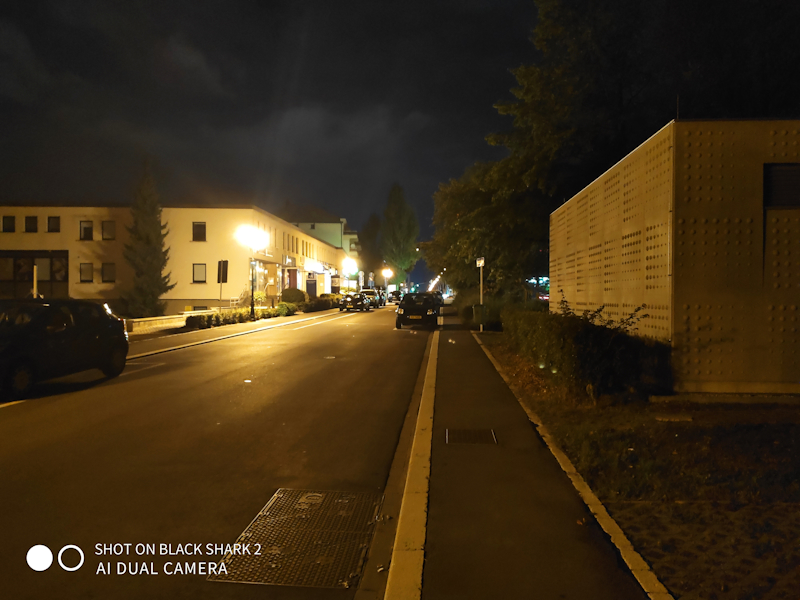
[ BlackShark 2 ] - [ S10+ (E) ] - [ S10+ (S) ]
[ Xperia 1 ] - [ P30 Pro ] - [ Mi9 ]
[ G8 ] - [ Reno 10x ] - [ RedMagic 3 ] - [ Pixel 3 ]
The next shot is again a disappointing blurry mess. I’d like to point out the result of the Red Magic 3 here – that phone uses the same camera sensor again and it also lacks OIS, both being gaming phones. Yet the RM3 managed to have a significantly better image that is much sharper.
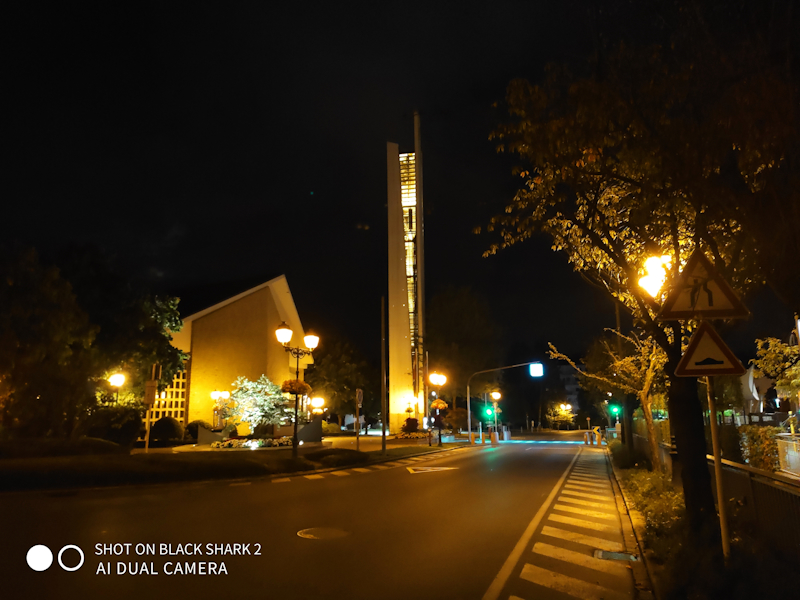
[ BlackShark 2 ] - [ S10+ (E) ] - [ S10+ (S) ]
[ Xperia 1 ] - [ P30 Pro ] - [ Mi9 ]
[ G8 ] - [ Reno 10x ] [ RedMagic 3 ] - [ Pixel 3 ]
Here we again see the same results. The BS2 ends up as the worst result amongst the line-up by quite a significant margin, and again I want to point out the differences to the RM3 that is leagues ahead even though both have almost the same hardware.
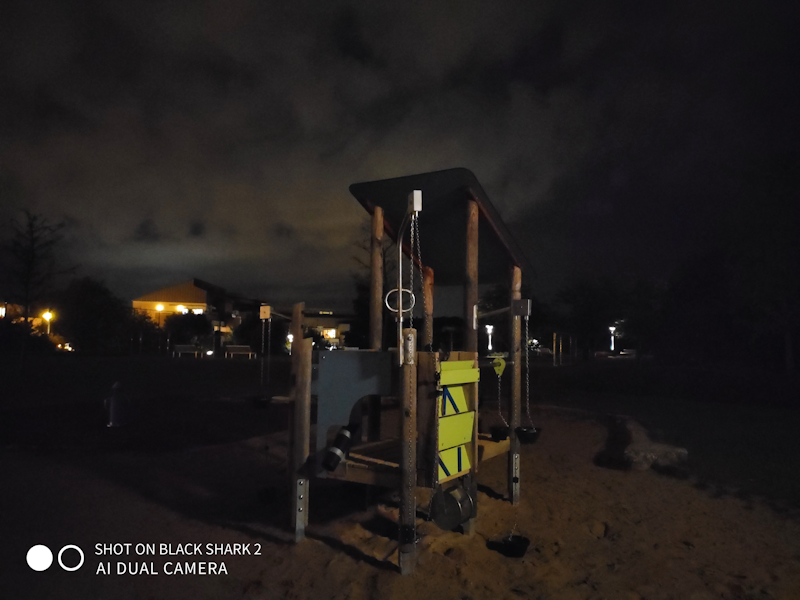
[ BlackShark 2 ] - [ S10+ (E) ] - [ S10+ (S) ]
[ Xperia 1 ] - [ P30 Pro ] - [ Mi9 ]
[ G8 ] - [ Reno 10x ] - [ RedMagic 3 ] - [ Pixel 3 ]
I was actually surprised to see the BS2 get in as much light as it did here in this shot as it’s extremely dim.
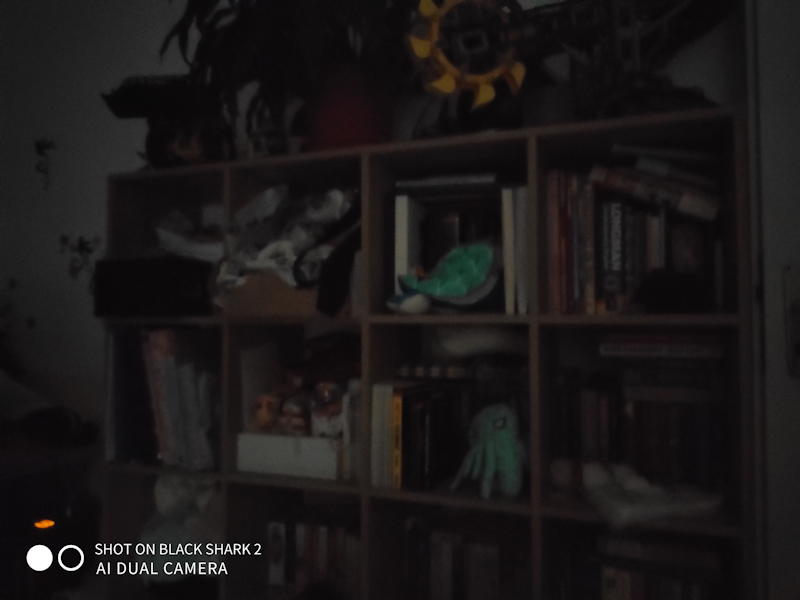
[ BlackShark 2 ] - [ S10+ (E) ] - [ S10+ (S) ]
[ Xperia 1 ] - [ P30 Pro ] - [ Mi9 ]
[ G8 ] - [ Reno 10x ] [ RedMagic 3 ] - [ Pixel 3 ]
Lastly, in this indoor low light shot, the BS2 couldn’t focus and the picture is largely unusable.
Low-light Conclusion - Also Terrible
The low-light conclusion for the BS2 doesn’t differ to much of that of the Mi9 – they’re both terrible at it. The situation for the BS2 is even more dire than that of the Mi9 as it doesn’t offer a dedicated Night Mode to at least attempt to capture more light and at least be able to produce images fit for social media.
I understand gaming phones aren’t camera oriented, but Xiaomi at least could have put the effort to just copy the camera processing from its main flagships for the Black Shark 2. As it is, it’s just pretty much unusable.
Conclusion & End Remarks
The Black Shark 2 is actually the first “gaming” phone that I’ve gotten to dedicate a review to. Going into the review I had a few preconceptions of what this means and what the basic checkmarks of what a gaming phone should be and what it should deliver.
First of all, in terms of design, the Black Shark 2 does put a checkmark on its “gaming aesthetics”, and the accentuated modern design elements of the phone very much remind one of the typical gaming products that consumers are accustomed.
The build quality of the phone is excellent and feels very solid; it’s also of a reasonable size and weight – keeping the size in check with delivering a gaming phone experience in a 75mm wide form-factor.
The Black Shark 2’s 6.39” AMOLED screen is quite adequate and should satisfy most users, albeit it doesn’t showcase any particular strengths and its colour calibration also seems to have larger weaknesses.
The best thing about the display is actually the touch input controller that operates at a higher-than-usual 240Hz, something that’s particularly noticeable in the scrolling latency of content and surely would also help in the touch input latency of games.
On the software side, I wasn’t too convinced of the value of the Shark gaming suite. In essence, it’s just a glorified launcher UI with a lot of gimmicks. The one real benefit I found to be actual a practical feature is the “MasterTouch” feature which allows you to map two pressure sensitive areas on the screen to two new additional adjustable UI functions in a game, essentially enabling you to turn in-game analog sticks to also serve as click-buttons, much like on a real controller joystick.
The cameras on the Black Shark 2 just aren’t very good. I had expected the phone to at least match the very good daylight processing of the Xiaomi Mi9, but alas that’s not the case, and the BS2 just doesn’t offer the same more consistent and superior camera calibration and post processing. It has worse exposure, colour balance, and details, especially on the zoom module that showcases a detrimental contrast and sharpening filter.
In low-light, the phone is actually even worse than the Mi9 due to the fact that it lacks the dedicated night mode. It’s in essence the worst camera I’ve tested in recent years.
A Gaming Phone's Existential Crisis
I mentioned I had preconceptions of what a gaming phone should be able to deliver, and the one aspect that I would value above all others in such a product, is the gaming performance that it's able to deliver.
On the CPU side of things, the BS2 fares quite OK and is about average to a little below average compared to other Snapdragon 855 devices. The benefit of this more conservative tuning is the fact that it does quite well in terms of battery life, and its 4000mAh battery does showcase itself as an advantage compared to other devices.
In terms of gaming/GPU performance, the Black Shark 2 is simply an utter disaster and an embarrassment of a device. The matter of fact here is that the phone ended up with the single worst sustained performance of any Snapdragon 855 phone in the market. The phone’s thermal throttling is very aggressive, and though it’s able to maintain very reasonable skin temperatures, it comes at a great cost of performance.
The problem here is that Xiaomi continues to try to mislead its customers as to the real performance of the phone – the firmware detects benchmarks and disables thermal throttling in order to get better scores. In this scenario of course it showcases excellent performance, but I stopped the phone in its tracks after it had reached an excess of 57°C, at which point it was uncomfortably hot to hold. The issue isn’t new to the Black Shark 2 as last year’s Black Shark behaved the same – showcasing great cheating behaviour while its real performance was just lacklustre.
Here’s the thing, the Black Shark 2 isn’t all that cheap, coming at a minimum of 549€ for the base storage model. For a phone which completely fails at the very thing it’s designed for, I can’t see how one would able to justify its purchase. The cameras are massively underwhelming, and the display is also lacklustre compared to other phones. The only redeeming features of the Black Shark 2 remains its 240Hz touchscreen, the MasterTouch feature, and above-average battery life.
Currently I just don’t see how the BS2 can justify its existence over any other regular non-gaming phone, the compromises and disadvantages vastly outweigh the one or two features which actually do benefit the phone.

